Free Editable Compare and Contrast Graphic Organizer Examples
A graphic organizer is the best helping tool in education to represent the comparison and contrast between concepts and entities. It makes it easier for students to map their ideas and compare attributes to look for similarities and differences logically. If you want to create and use graphic organizers, check out our templates and example below. You can also learn about various graphic organizers and their uses.

1. What is Compare and Contrast Graphic Organizer
A compare and contrast graphic organizer visualizes similarities and differences between two or more concepts, people, items, or events. It depicts relationships between two or more data sets using various organizers such as a Venn diagram or a T chart. It helps students create a graphical map to represent their thoughts in an easy-to-understand format. Graphic organizers are commonly used as a creative studying tool for students and business presentations and reports.
2. The Compare and Contrast Graphic Organizer Examples
Graphic organizers are easy to use, and you can use them for any content area to depict information and concepts in an orderly visual representation. The term graphic organizer does not refer to a single diagram type. You can use various diagrams or charts and graphic organizers based on the entities you want to compare. Our compare and contrast graphic organizer templates will help you find a suitable diagram type. You can check out our examples and pick the one you want. Please remember that graphic organizers help students organize their thoughts to compare concepts and ideas.
Example 1: Compare and Contrast Graphic Organizer
This is a compare and contrast graphic organizer example. The diagram type used in this template is a Venn diagram. A Venn diagram visually represents similarities and differences between two or three data sets with overlapping circles. It depicts the relationship between concepts and compares the attributes of various groups. The overlapping part of the circles represents the similarities, and the rest of the area means the contrast. Venn diagrams are also used to solve complex math equations.

Example 2: Graphic Organizer Compare and Contrast
This is an example of a graphic organizer compare and contrast. Diagrams such as the one in this template are mainly used for education purposes, and educators use these diagrams to familiarize students of smaller grades with compare and contrast concepts. It is a simple logic diagram with creative images and bright colors that most kids like to read, and it helps them easily memorize the content and become more creative. The area of the diagram labeled as the same depicts the matching concepts of the two data sets.

Example 3: Compare and Contrast Essay Graphic Organizer
This is a compare and contrast essay graphic organizer template. The first paragraph of a compare and contrast essay introduces the essay topic, and it is always written at the top. In the first paragraph, the writers write down their ideas and concepts. After giving the topic sentence, the writer depicts the reasons or comparison for the assigned essay in the second paragraph. It makes it easier to determine the critical parts of an essay without reading it from start to end.

Example 4: Graphic Organizer for Compare and Contrast
This graphic organizer example compares and contrasts attributes of two data groups or concepts. The diagram in this example is a set diagram. With the help of a set diagram, comparing two data groups is simple, and any reader can easily understand the similarities and differences between those data groups. When educators use these diagrams to teach lower-grade students, they add icons and colors to make the graphic organizer more attractive.

Example 5: Compare and Contrast Graphic Organizer Template
This is a compare and contrast graphic organizer template used by educators to teach their students about comparing two groups and organizing data and their ideas logically. The first half of this template is a Venn diagram that depicts the comparison between two groups. In the lower half, students can add images and list the similarities and differences between both groups based on the Venn diagram.

Example 6: Compare and Contrast Graphic Organizer Free
This is a compare and contrast graphic organizer free template that school teachers use to give students home assignments and tests. It follows a simple format where students write the title or name of both data groups at the top. In this template, the students are comparing two classic books. After the title, students write the words of authors for each book. After that, the students reach the theme of both books.

Example 7: Compare and Contrast Graphic Organizer Example
This is a compare and contrast graphic organizer example. Templates such as this one are mainly used to compare two images or data groups that look identical but are not the same. The format is simple and easy to understand for the reader. At the top, we got the images of each group, and after that, the graphic organizer divides the comparison into two sections. The first section lists the differences, and the second section lists the similarities in an organized manner.

Example 8: Compare and Contrast Chart
The compare and contrast chart in this example uses a Venn diagram as a graphic organizer to show relationships between two data groups and depict their similarities and differences. Overlapping circles in a Venn diagram represent similarities between both groups, and the overlapping area contains the same attributes, while the other regions have differences. Venn diagrams are the most efficient educational tools that help teach students logical representation of ideas and concepts.

Example 9: Compare and Contrast Graphic Organizer Middle School
This is an example of compare and contrast graphic organizer in middle school. It uses a double-semantic map or a bubble map. Sematic maps are mostly used to represent the relationship between two words or data sets graphically. The topic words are mostly placed at the center on the left and right sides of the diagram. Between both of these words are their similarities, while their differences are on their left and right sides. It makes it easier to understand the similar attributes of both words or data groups.

3. Online Compare and Contrast Graphic Organizer Maker
Compare and contrast graphic organizers help visualize our thoughts and explain the differences and similarities between two concepts or entities. Although a graphic organizer is easy to understand for any reader making one takes some time and effort if you don't have the right helping tool. EdrawMax Online is the best compare and contrast graphic organizer maker out there. It gives you a comprehensive templates and symbols library that you can use and edit in a few clicks. Having pre-made templates saves both your time and effort.
4. Key Takeaways
You can use various graphic organizers to compare and contrast data sets and entities. Each compare and contrast graphic organizer comes with its features and uses. As an educator or a student, you have to make sure you are using the correct graphic organizer. EdrawMax Online is the best diagramming software to create a compare and contrast graphic organizer. It also gives you an extensive template collection that you can use for your diagram. You can also get the example templates listed above from EdrawMax. Find more graphic organizer template in the template community.

Free Editable KWL Chart Templates Examples

Free Editable Bubble Map Examples

Free Editable Biography Graphic Organizer Examples

Free Editable Brainstorming Graphic Organizer Examples

Free Editable Cause and Effect Graphic Organizer Examples

Free Editable Lotus Diagram Examples

Compare and Contrast Graphic Organizer Complete Guide
Edraw content team, do you want to make your compare and contrast graphic ogranizer.
EdrawMax specializes in diagramming and visualizing. Learn from this compare and contrast graphic organizer complete guide to know everything about compare and contrast graphic organizer. Just try it free now!
The art of comparing and contrasting is required in almost all sectors of daily life. Doesn't matter if you are a student or an individual working in a professional environment; you may need to compare and contrast different people or ideas. It is indeed a tough nut to crack. To deal with these challenges, the mathematicians introduced compare and contrast graphic organizers .
Venn diagrams are the most famous graphic organizers. They were introduced for the first time by John Venn in 1880. These compare and contrast diagrams have proved to be pretty useful for learners of all ages. One thing that makes " compare and contrast graphic organizers " stand out is that they are very easy to customize for any content you want.
Are you looking for a credible source to gather information covering what precisely a compare and contrast graphic organizer is, what types it is available in, and how to create it within a few minutes? This is a perfect read for you. Let's get deeper into the discussion.

1. What is the Compare and Contrast Graphic Organizer
A compare and contrast graphic organizer helps you utilize your study to compare and contrast two or more ideas, perspectives, events, policies, and people. Depending on your requirements, you can use this organizer in different ways, as listed below.
- Compare and contrast two huge ideas like constitutional democracy and direct democracy.
- Compare and contrast the characteristics of two well-known personalities.
- Compare and contrast the impact of two policies or events.
There are numerous methods for comparing and contrasting the characteristics of objects, individuals, events, and so on. Many different types of graphic organizers make examining these similarities and differences much easier.
- Compare - to evaluate (two or more objects, thoughts, persons, or other things) in order to find similarities and differences. For instance, to compare two literary works.
- Contrast - demonstrate unlikeness or differences; note the opposite natures, purposes, etc. For instance, compare and contrast the political rights of Romans and Greeks.
A compare and contrast graphic organizer helps you utilize your study to compare and contrast two or more ideas, perspectives, events, policies, and people.
2. Types of Compare and Contrast Graphic Organizer
Graphic organizers come in a variety of types. The suitable one depends on the task at hand. Some common formats include Tree, Cloud/Cluster, Flow Chart, Sequence Chart, Maps, Graphs, T Chart, Story Maps, Venn diagrams, and many more. Let's explore some commonly used types of compare and contrast graphic organizers .
- Venn Diagrams
A Venn Diagram is a graphic organizer composed of two or three circles that overlap. Venn diagrams play a key role when you need to compare and contrast two or more concepts. These diagrams are generally used to compare similar ideas to determine what makes them similar and different from each other. The Venn diagram shown below displays the comparison and contrast of three different concepts. John Venn, an English mathematician, invented these in 1880.
The best thing about the use of A T Charts is that you can create them within a few minutes, and it efficiently compares and contrasts two ideas. To create a T Chart, all you need is to draw one vertical and one horizontal line. The horizontal line intersects the vertical line from the top (this is how it becomes t-shaped) and divides it into two equal parts, as shown below.
The graphs are perfect for comparing and contrasting graphic organizers when you need to visualize and evaluate the numerical data of two or more concepts or ideas. They are equally good to use for non-numerical problems. The below picture shows how graphs look alike.
- Tree Diagrams
Tree diagrams break or divide the main concepts into multiple mini ideas to better understand the whole scenario. It supports a hierarchical organization. Both tree diagrams and flowcharts are pretty similar to each other. These diagrams show how every step or phase of the project or idea is connected to each other. The below picture shows a tree diagram. The box placed at the top is the main idea, and other boxes show the broken parts of the main idea.
3. Benefits of Compare and Contrast Graphic Organizer
Teachers and students use graphic organizers for a variety of reasons. Graphic organizers are useful teaching tools that make studying more interesting and productive by demonstrating relationships, visualizing and simplifying concepts, and organizing knowledge. A few of its benefits are stated below.
- Indicate Relationship
Graphic organizers help students imagine the relationships between various parts by using colorful shapes, icons, and connectors. Venn diagrams, for example, help students see and understand the similarities and differences between objects.
- Clarify Concepts
Graphic organizers may also simplify complex concepts by visualizing them, as an image is worth a thousand words. Ideas that can be seen are easier to comprehend, particularly for the learning process.
- Analyze the data
It is difficult for the brain to interpret and process a vast volume of information. The details can be logically organized using the graphic organizer. For instance, charts can help remember the difference between two objects, places, persons, etc.
4. How to Make a Compare and Contrast Graphic Organizer in EdrawMax
Worried about creating a compare and contrast graphic organizer tailored to your needs? EdrawMax is here to reduce your headache. Give it a try, and you will be amazed to see the features it offers.
Step1 Download, Install and Launch EdrawMax
Start with downloading and installing EdrawMax on your PC or laptop. It will take a few minutes only. Launch the software and hit the " Sign In " button as soon as you install it. If this is the first time you are installing this tool, click on the " Create Account " to create a new EdrawMax account. Now, provide the desired information and press the " Create Account " button. If you already have an account, you can simply log in to EdrawMax by putting your registered email and password.

Step2 Choose a Built-In Template
The availability of editable templates makes it easy for you to deal with complex problems. To find the desired templates, all you need is to click on the " Templates ". You will find it in the left menu bar, as shown below. Now, type " compare and contrast graphic organizer " in the search bar, and you will see a couple of templates over there. Select the one that suits your needs the best and go ahead.

Step3 Making Graphic Organizer from Scratch
Don't you feel comfortable with using the built-in templates? No worries! EdrawMax provides you with an opportunity to create your compare and contrast graphic organizers from scratch. Tap on the "New" option from the left menu and press the button " Blank Drawing ", as shown below. Once done, you will see a new window on your system's screen. There, you can draw any type of graphic organizer like a Venn diagram, T Chart, Graphs, Maps, etc.

Step4 Select the Symbols
A wide variety of symbols and basic drawing shapes are available to make graphic organizers. Let's use the " circle " symbol and draw a Venn diagram. Tap on the " Symbol " menu from the top and click on the " circle ". Now, draw three circles in a way that they slightly overlap each other, as displayed below. Once you are done with making your graphic organizer and want to change its position on your screen slightly, hit the " Select " option, click on the graphic organizer, and move it to any position you want.

Step5 Customize Your Graphic Organizer
Customization makes the whole idea easy to understand. EdrawMax offers different components to create a graphic organizer. Adding labels, engaging colors, and specific instructions to your drawing adds extra value to it. The below picture presents a Venn diagram that shows similarities and differences between three concepts (displayed with the three circles). The overlapped region shows similarities, whereas the remaining part of the circles displays key differences.

Step6 Export the Final Compare and Contrast Graphic Organizer
Is your compare and contrast graphic organizer designed? Great! Now, you can export it to any format you want. The most commonly used file formats available in EdrawMax are; Microsoft PowerPoint, Word, Excel, HTML, Graphics, SVG, and PDF. Go to the top menu and click on the " File " option. Now, tap on " Export & Send " and choose any file format to export the final drawing.

Tips & Considerations
While creating a compare and contrast graphic organizer in EdrawMax, don't forget to conduct detailed research to understand what the topic demands and what is better to include. Try inserting pictures to make the drawing more appealing. You can introduce a color coding scheme to improve the overall learning experience. Utilize different components like pen, shape formatting, and connectors.
Basically, it is simple to create a graphic organizer in EdrawMax, just grab a template and keep customizing, drag and drop professinal symbols to make your plan better. If you are still confusing about how to create a graphic organizer in EdrawMax, just check this graphic organizer guide , or check the video below. Or you can find more tutorial videos from our Youtube .
5. Free Compare and Contrast Graphic Organizer Examples & Templates
There are 7 examples of graphic organizer that you can refer or use immediately. Just click the image to download EdrawMax , and download the templates accordingly. Then double click to open the templates and customize as your prefer. Or open the templates from EdrawMax Online, and duplicate the templates. Click this graphic organizer examples to get more inspirations.
Example 1: Venn Chart
Above is an example of a Venn diagram template available at EdrawMax. A Venn diagram is a diagram that uses circles to depict relationships between objects or finite groups of objects. You can make use of this template to compare and contrast the similarities and differences of two or more objects, ideas, concepts, products, places, etc.
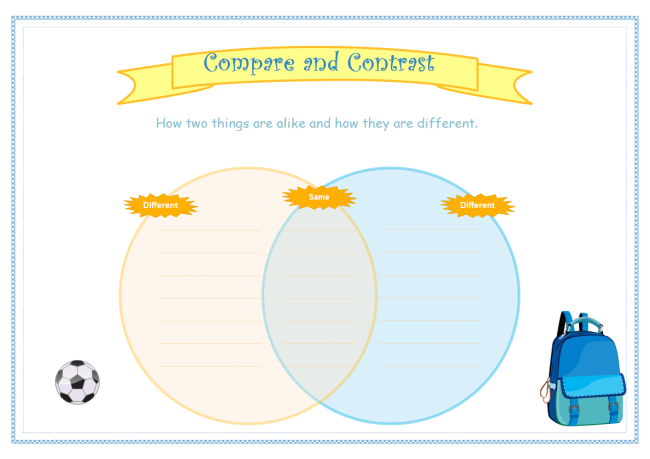
Example 2: Compare and Contrast Worksheet
This compare and contrast worksheet is simple but very useful. You can print it out and let students fill in the blank areas when you teach them to differentiate two concepts or items. If you want to change the number of text boxes in the "different" part, you can download the EDDX file of the template and edit it in EdrawMax.
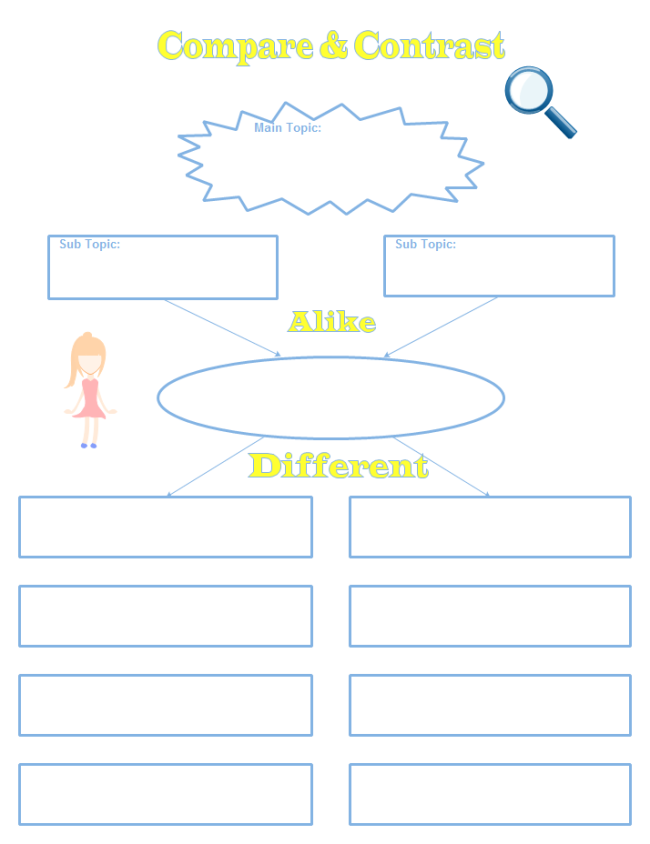
Example 3: Compare and Contrast with Topics
This cute comparison and contrast diagram template is great to be used in PPT presentations and worksheets. It will make students' homework interesting and enjoyable. Come and click the picture to download the PDF or EDDX file.
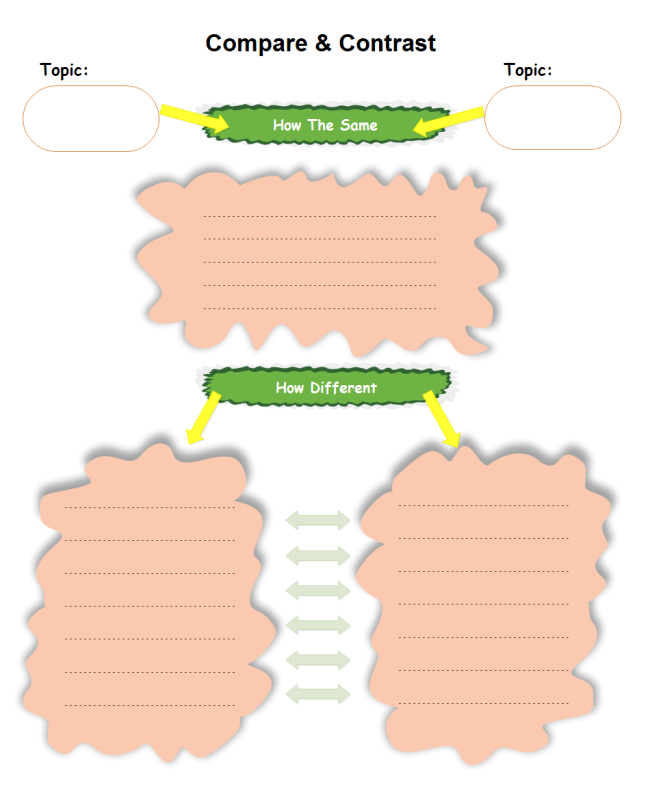
Example 4: Compare and Contrast Chart for Students
This compare and contrast chart is designed to help your students with better analyzing of the similarities and differences between two concepts. Download it now and save tons of time from creating similar graphic organizers.
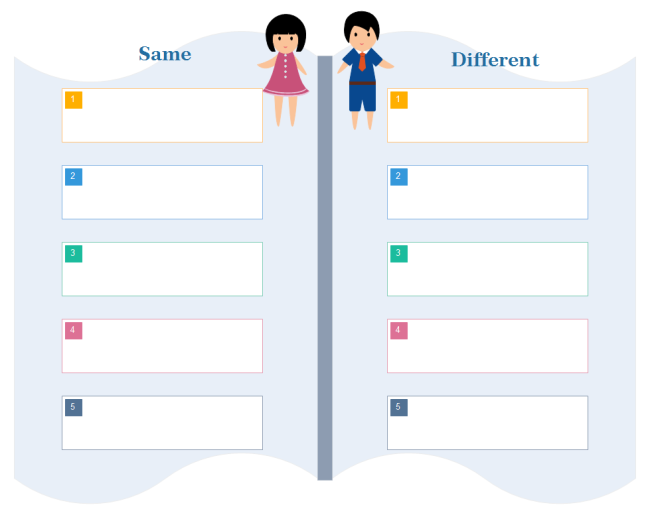
Example 5: Comparing and Contrasting Rain & Snow
The graphic organizer has made it super easy for researchers and scientists to compare and contrast complex topics like snow and rain conveniently. The figure below presents a detailed analysis of the differences and similarities between snow and rain and helps students creatively understand the overall scenario. As far as the learning process is concerned, the colorful visuals and graphics make it more appealing and engaging.
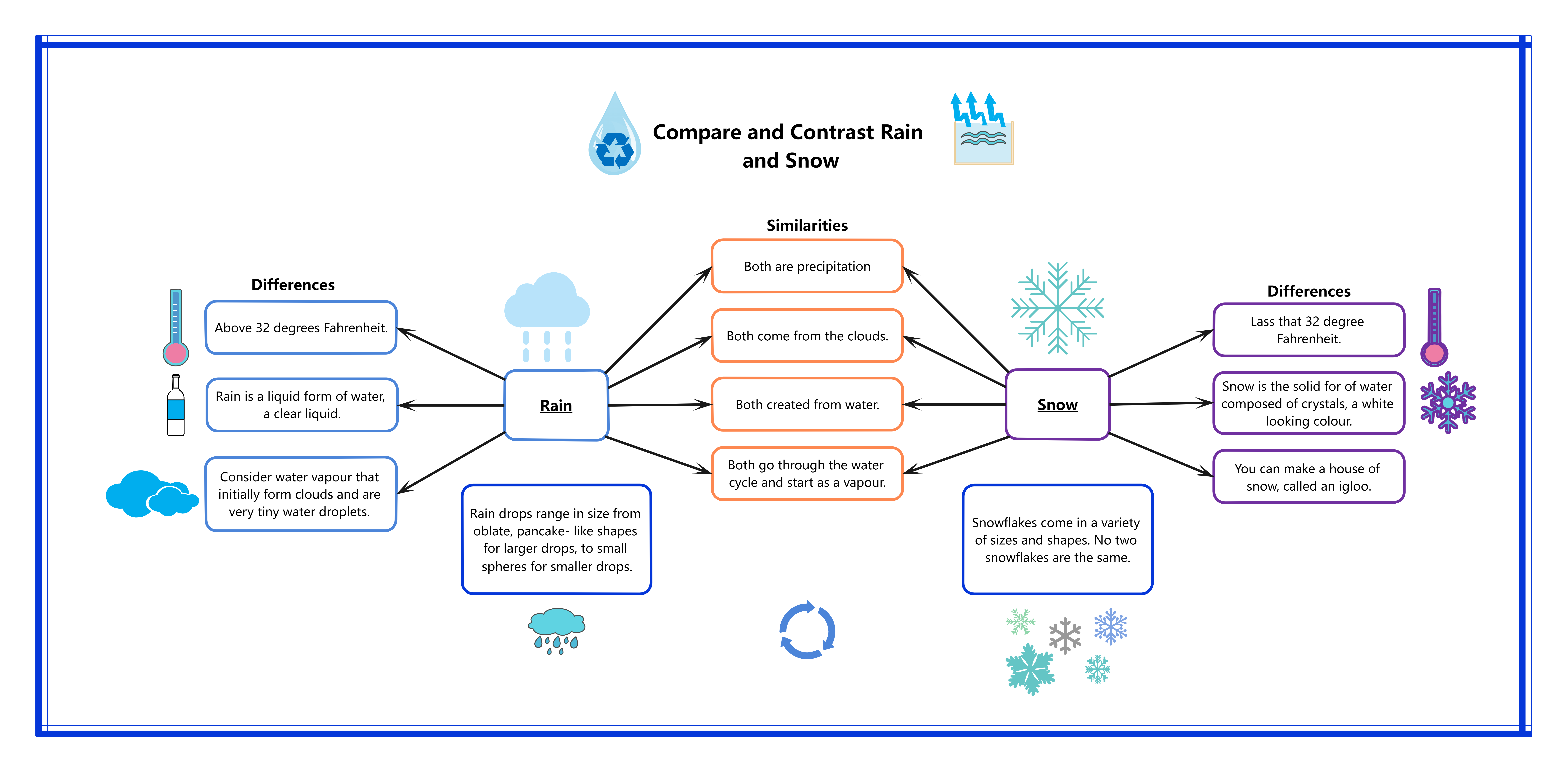
Example 6: Compare and Contrast Two Ideas (Fiction vs. Nonfiction)
The T Chart below compares and contrasts the two big ideas, i.e., fiction and nonfiction. The different traits are listed in tabular form to better understand how these two concepts are different and similar to each other. The traits compared in the table are; how literature is made, what is its purpose, what is it used for, and what it offers.
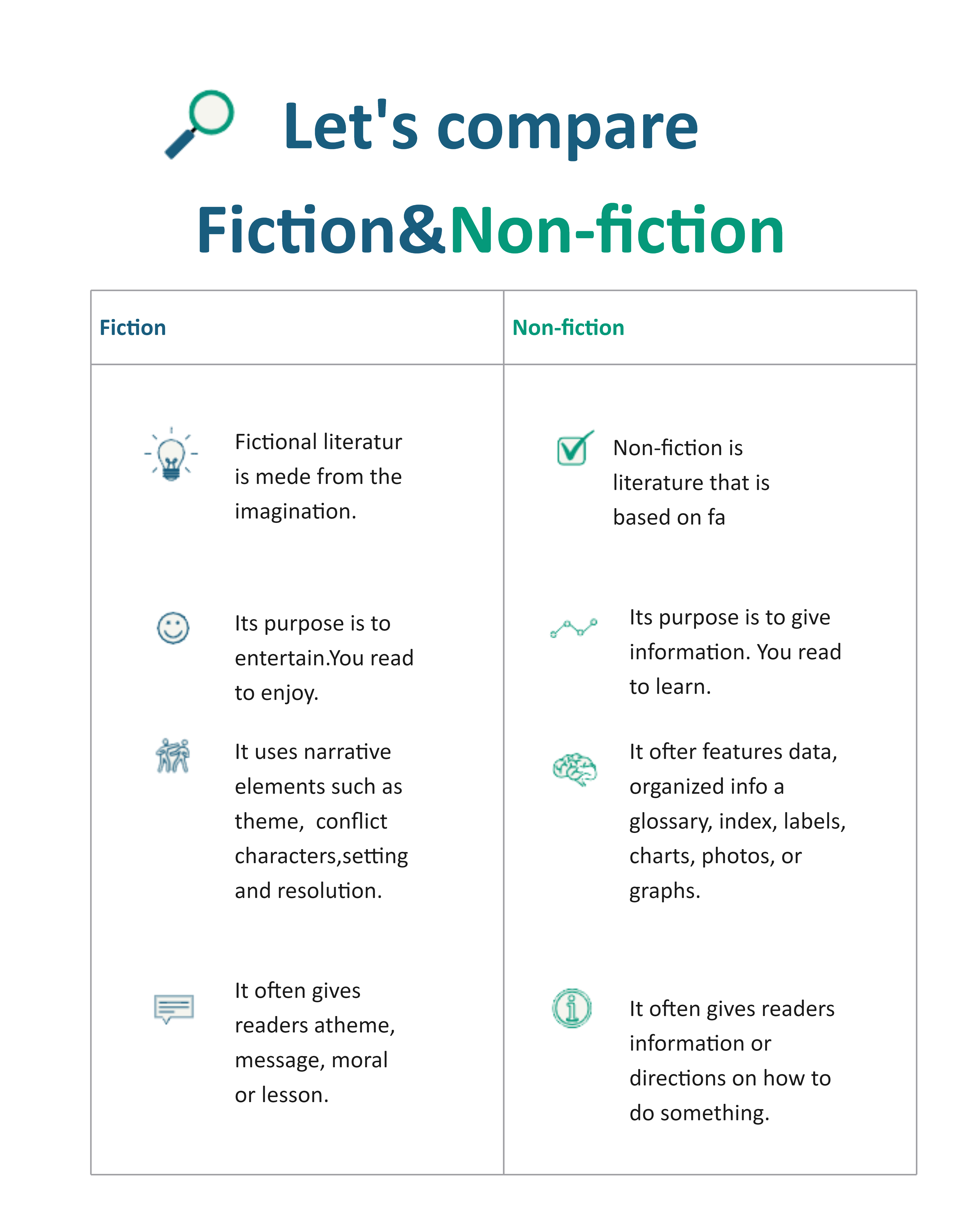
Example 7: Compare and Contrast Students' Ideas
This example is all about understanding the similarities and differences between two different student ideas. A double bubble map is drawn to understand the whole concept easily. This map is used for a variety of purposes, e.g., comparing and contrasting two or more artifacts, places, persons, ideas, and events.
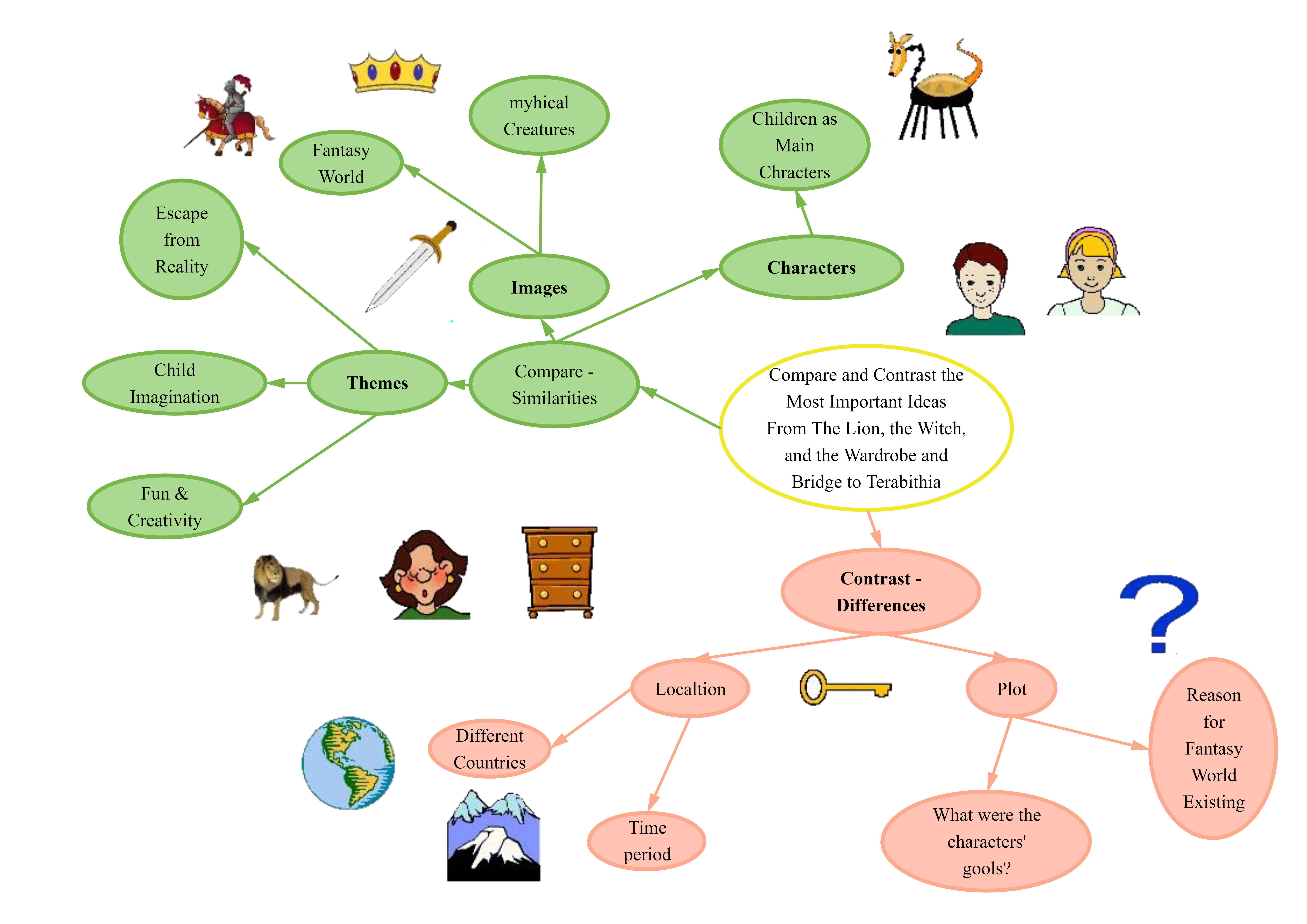
6. Free Compare and Contrast Graphic Organizer Software
Are you on the hunt for a versatile tool to create graphic organizers according to your requirements? Worried about the pricing factor? Look no further! EdrawMax is a trusted software that helps you create engaging graphic organizers for free. The best part of using this diagramming tool is that you can make editable graphic organizers and mold them for any content or idea. The world's top-rated brands have recognized EdrawMax and have been using this tool for many years.
EdrawMax promotes independent learning with the help of engaging visuals and graphics. It helps you solve complex problems by visualizing your target goals. If you run a team of professionals, you can use this diagramming tool to make a timeline and assign work to every member of the team. Some great features of EdrawMax are:
- A huge number of customizable templates
- Complete diagramming power
- Customized shapes and fonts
- File backup and encryption
- Supports popular file formats (e.g., graphics, PDF, Excel, HTML, Word, PowerPoint, SVG) to export the final drawing
The most appealing factor associated with EdrawMax is that it is trusted by more than 25 million users around the globe.
7. Final Thoughts
Do you often need to compare and contrast two or more concepts, policies, or people? Find it difficult to do this all manually? Looking for a helping hand to assist you in this regard? This is where a compare and contrast graphic organizer comes in. It is available in different types, e.g., graphs, maps, tree diagrams, flow charts, Venn diagrams, and the list goes on.
Every type of compare and contrast graphic organizer has its unique functions, and you can choose any of them keeping in mind your requirements. Do you want to create a graphic organizer on your own? Look no further than EdrawMax. It is a reliable and trusted software that not only helps you make a compare and contrast graphic organizer, but you can also create any other drawing you want.
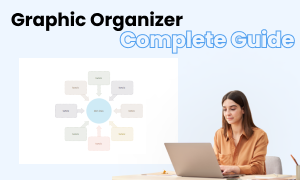
Graphic Organizer Complete Guide
Check this complete guide to know everything about graphic organizer, like graphic organizer types, and how to make a graphic organizer.
You May Also Like
Conceptual framework complete guide, dichotomous keys complete guide, rack diagram complete guide, network topology complete guide, project management network diagram complete guide, aws architecture diagram complete guide.

Compare and Contrast Graphic Organizer: Definition, Benefits, and Examples
4 minutes read
What is compare and contrast graphic organizer?
A compare and contrast graphic organizer is a visual tool that helps students organize their thoughts and compare two or more concepts, people, items, or events. It is a useful tool for students to map their ideas and compare attributes to look for similarities and differences logically. There are various types of graphic organizers that can be used for comparison and contrast, such as a Venn diagram or a T chart.
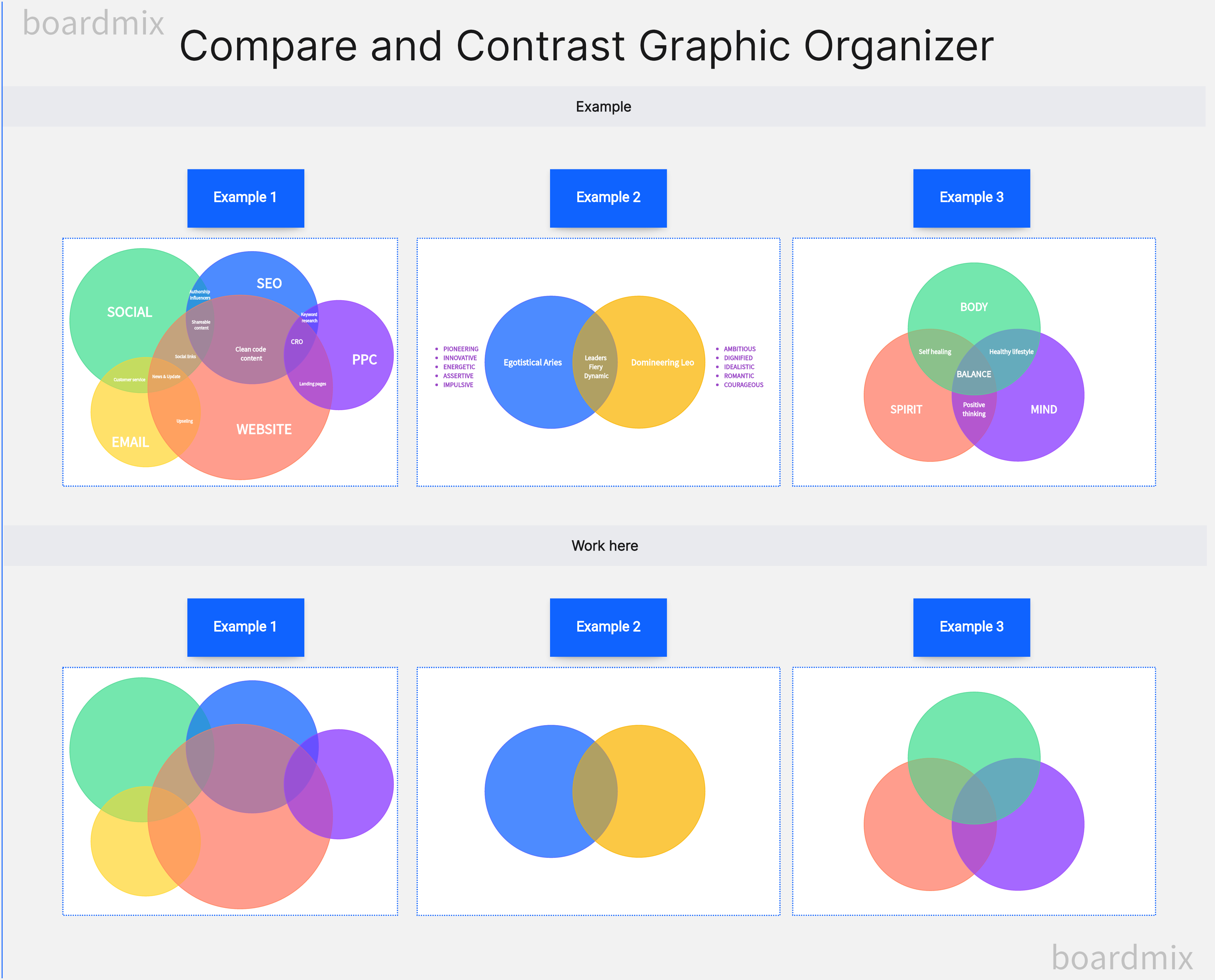
When to use compare and contrast graphic organizer?
A Compare and Contrast Graphic Organizer can be utilized in various situations where analyzing the similarities and differences between two or more subjects is beneficial. Here are some instances when it would prove especially useful.
Academic Study: This tool is often used in classrooms across various subjects, such as literature (to compare two characters or two books), history (to compare two historical events), science (to compare different species), and more.
Essay Writing: It's an effective way to plan compare and contrast essays by systematically arranging ideas and points of argument.
Decision Making: It can also be a practical tool outside of an academic context, such as comparing and contrasting different product options before making a purchase.
Problem Solving: It's useful in understanding different aspects of a problem, its causes, and effects by comparing it to a similar situation or problem.
Presenting Information: It is used in business presentations or reports to compare different strategies, outcomes, or options.
Remember, a compare and contrast graphic organizer online tool is a flexible tool that can be adapted to suit many learning and decision-making contexts.
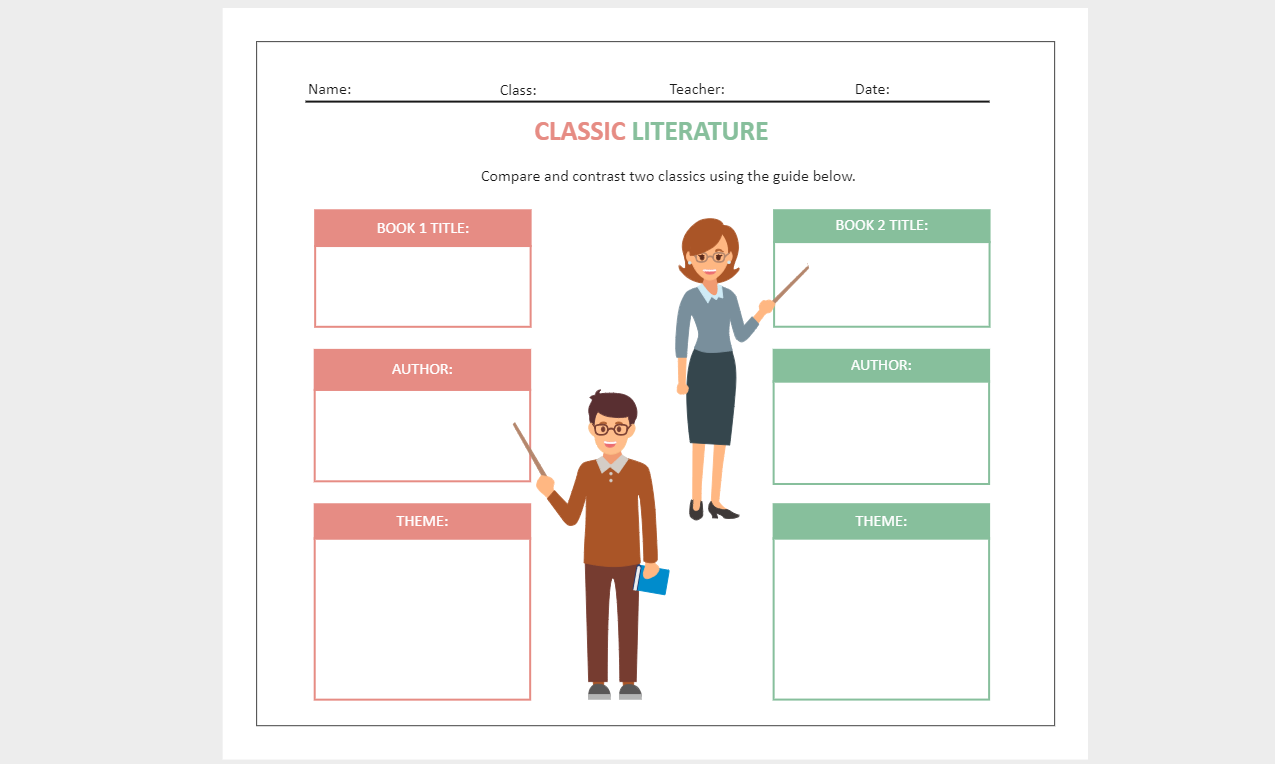
Benefits of Using Compare and Contrast Graphic Organizers
1. enhances critical thinking.
By organizing information visually, compare and contrast graphic organizers enhance critical thinking. They help users to examine the relationship between different concepts, promoting deeper analysis and understanding.
2. Facilitates Understanding
These organizers aid comprehension by simplifying complex information. By presenting similarities and differences in a structured format, they help users understand the unique characteristics and commonalities between different ideas or concepts.
3. Encourages Engagement
They offer an engaging method of learning, particularly for visual learners. Presenting information in a visually organized manner helps users stay engaged with the material, leading to improved information retention.
4. Aids In Decision-Making
In practical scenarios, compare and contrast graphic organizers can aid decision-making. By analyzing the pros and cons of different options in a systematic way, they enable more informed decisions.
5. Supports Writing
For writing tasks, these organizers serve as a valuable prewriting tool. They can help students plan out their essays, making it easier to write clear and coherent compare-and-contrast essays.
6. Boosts Creativity
By provoking a deep analysis of subjects, compare and contrast graphic organizers can foster creativity. They encourage users to think about subjects from different perspectives, often leading to novel insights or ideas.
By presenting information in a clear, organized, and interactive format, compare and contrast graphic organizers are versatile tools that offer significant benefits in various learning, decision-making, and creative scenarios.
Creating a Compare and Contrast Graphic Organizer on Boardmix
Boardmix is a digital tool that's ideal for creating visually appealing and efficient graphic organizers. Here's how you can design a Compare and Contrast Graphic Organizer using Boardmix.

1. Log In to Boardmix
Firstly, visit the Boardmix website and sign in to your account. If you haven’t registered yet, you can quickly sign up for a free account.

2. Start a New Project
Once you’re logged in, you will see a dashboard where you can start a new project. Click on Plus Board to open a blank workspace where you will create your compare-and-contrast graphic organizer.

3. Choose a Template
Boardmix provides several templates for different types of graphic organizers. Find a suitable template for a compare and contrast graphic organizer and select it. You can choose between a Venn Diagram format or a Two-Column format based on your preference.
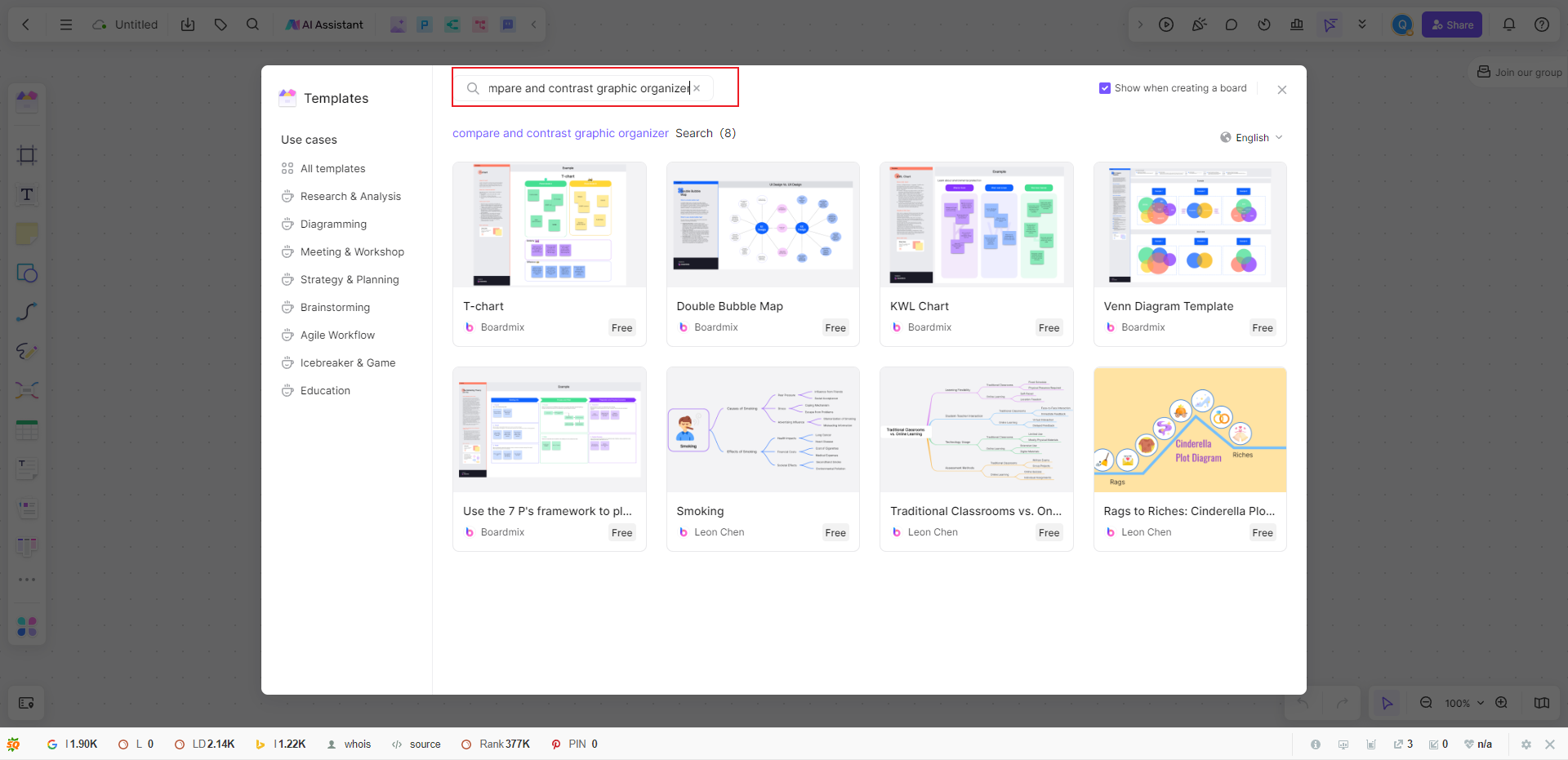
4. Input Your Subjects
Begin by naming your subjects or concepts in the designated areas of the organizer. For a Venn Diagram, each circle will represent one subject, and the overlapping area will represent similarities. In the Two-Column format, each column will represent one subject.
5. Fill in the Details
Now, fill out the details for each subject, identifying their unique characteristics as well as their similarities. In the case of a Venn Diagram, the unique characteristics will go into the non-overlapping parts of the circles, while the common features will go into the overlapping area.
6. Customize Your Organizer
Boardmix allows you to customize your organizer for improved visual clarity. You can change font styles and sizes, adjust colors for differentiation, or even add images if it helps to visualize your subjects.
7. Save and Share Your Organizer
Remember to save your work as you progress to avoid losing any information. Once you have completed, you can get a free compare and contrast graphic organizer pdf file or image file, and you also can share it with others by email or generate a shareable link.
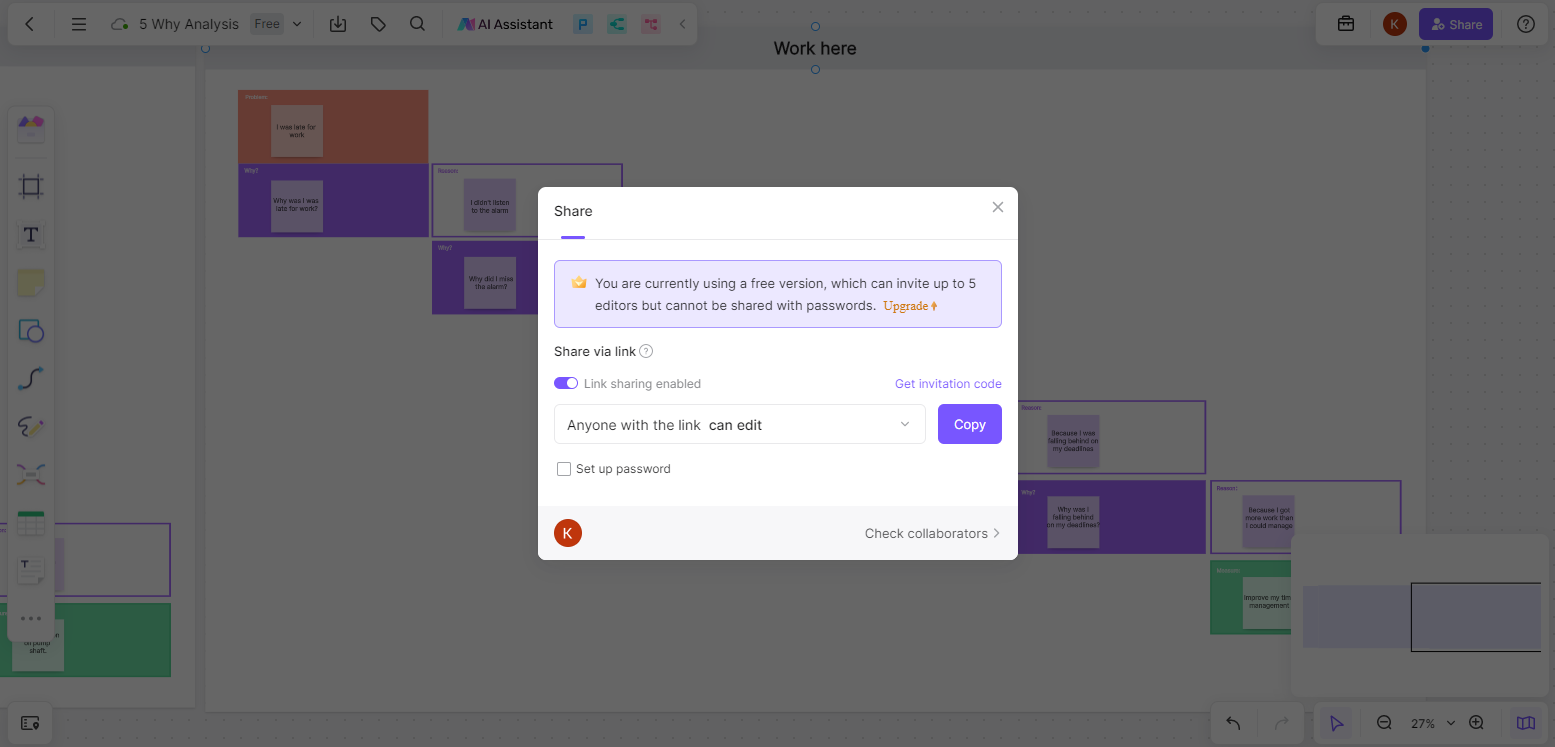
Creating a compare and contrast graphic organizer on Boardmix not only helps you systematically organize information but also enhances understanding by visualizing similarities and differences between concepts or subjects. Take advantage of Boardmix's easy-to-use and customizable features to create effective compare and contrast graphic organizers!
Join Boardmix to collaborate with your team.
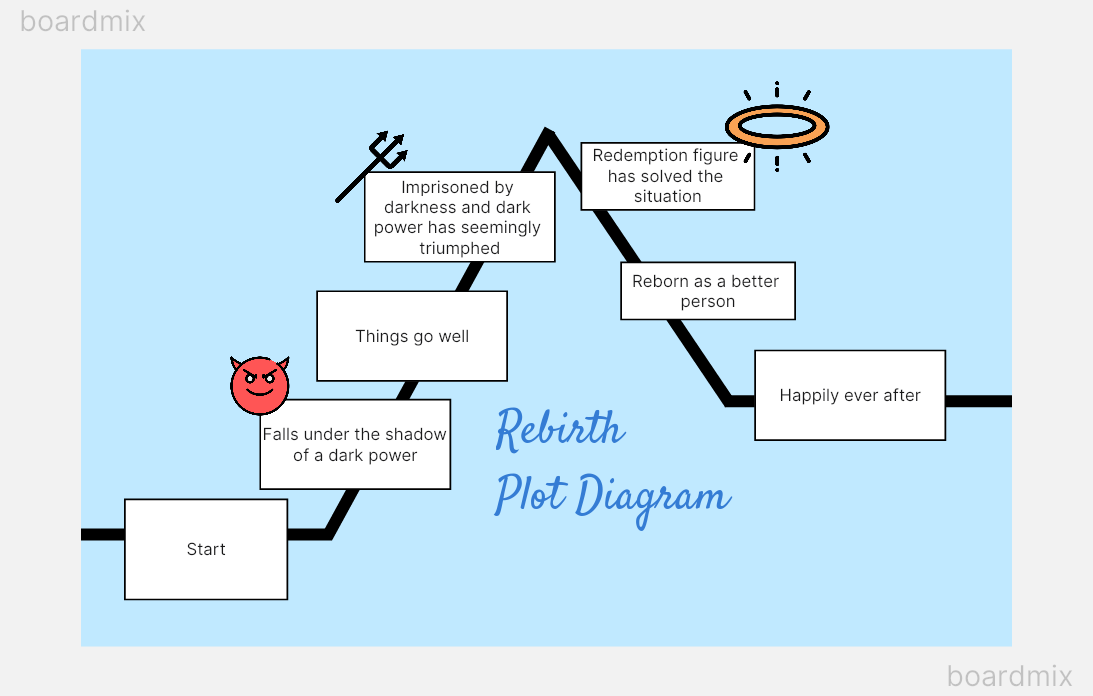
Mastering the Art of Storytelling with Plot Graphic Organizers
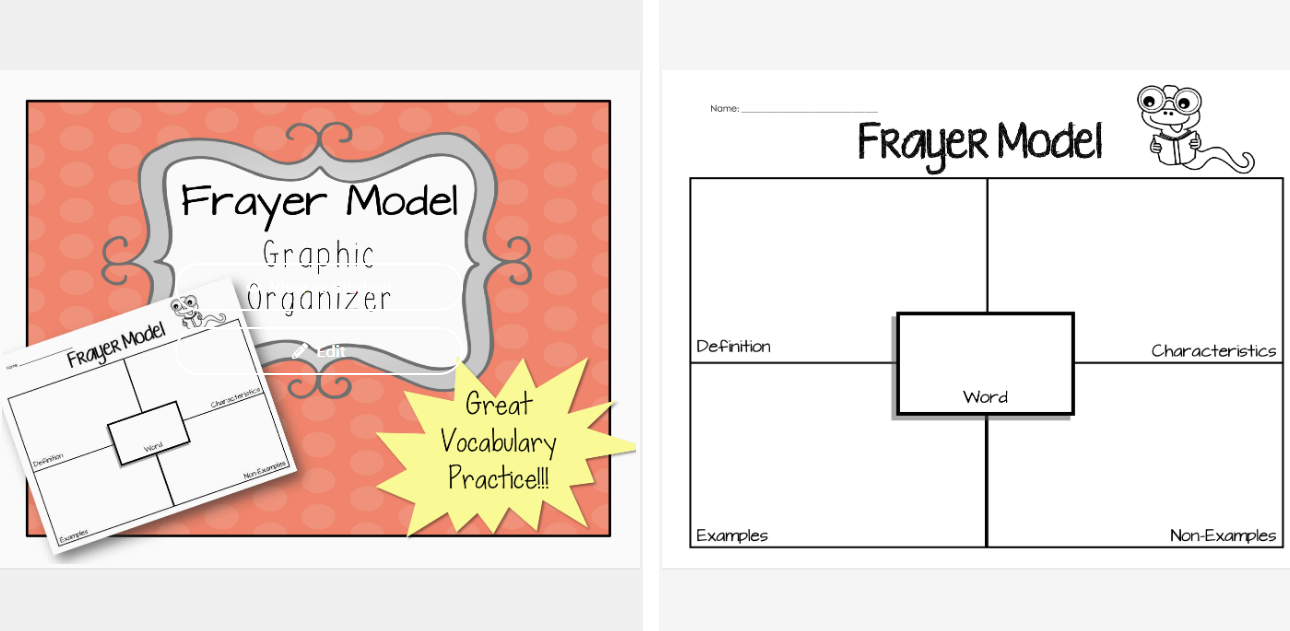
Frayer Model Graphic Organizer: A Simple Yet Effective Tool for Conceptual Learning

Mastering Project Documentation: A Comprehensive Guide to Effective Project Management Documents

The Ultimate List of Graphic Organizers for Teachers and Students
Graphic organizers integrate both text and visuals. This has been scientifically proven to be an effective way of teaching and learning. Using them can be extremely useful for both teachers and students as they will make lessons more engaging as well as easily comprehensible.
We have listed below multiple types of graphic organizers you can use during various scenarios, whether you are reading, writing, doing research or studying for exams. Each tool is accompanied by a template that you can use right away.
1. What are Graphic Organizers
1.1. Benefits of graphic organizers
2. Types of Graphic Organizers
2.1. Graphic Organizers for Writing
2.1.1. 1. Persuasion map
2.1.2. 2. Sequence Chart
2.2. Graphic Organizers for Reading
2.2.1. 3. Story map
2.2.2. 4. Biography graphic organizer
2.2.3. 5. KWL chart
2.3. Graphic Organizers for Teaching
2.3.1. 6. Learning map
2.3.2. 7. Analogy graphic organizer
2.3.3. 8. Vocabulary graphic organizer
2.3.4. 9. Problem-solving organizer
2.3.5. 10. Math Graphic Organizer
2.4. Graphic Organizers for Learning
2.4.1. 11. Timeline graphic organizer
2.4.2. 12. T chart
2.4.3. 13. Hierarchy chart
2.4.4. 14. Star diagram
2.5. Graphic Organizers for Brainstorming
2.5.1. 15. Cluster diagram
2.5.2. 16. Lotus diagram
2.5.3. 17. Cause and effect graphic organizer
2.5.4. 18. Mind map
2.6. Graphic Organizers for Compare and Contrast
2.6.1. 19. Double bubble map
2.6.2. 20. Venn diagram
2.6.2.1. Add to Our List of Graphic Organizers for Teachers and Students
What are Graphic Organizers
A graphic organizer is a teaching and learning tool that is used to organize information and ideas in a way that is easy to comprehend and internalize. By integrating text and visuals, graphic organizers show relationships and connections between concepts, terms, and facts.
Graphic organizers can be used in all grade levels, and have proven to be effective learning tools for gifted children and students with special needs. And with adult learners, graphic organizers can help enable the connection between what they already know and newly acquired knowledge.
Benefits of graphic organizers
Different types of graphic organizers can be used across the curriculum for teaching, learning, and note-taking. They are easy to create and impactful in simplifying information.
- Help visualize or present information in a way that is easier to comprehend, by breaking down larger or complex concepts or ideas into smaller and simpler parts.
- Provide students the opportunity to actively contribute and participate in the learning process through the creation of graphic organizers.
- Help develop cognitive skills such as brainstorming, critical and, categorizing and prioritizing content, reflection, etc.
- Help recall prior knowledge about a subject and quickly connect it to new information
- Promotes self-learning. By using graphic organizers for note-taking, analyzing, studying, etc. students can familiarize themselves with a lesson far more easily.
Types of Graphic Organizers
Here we have listed 19 types of graphic organizers for teaching and learning. Based on their varied purposes, you can utilize them in reading, writing, researching, brainstorming, and analyzing.
Graphic Organizers for Writing
1. persuasion map.
The persuasion map is an interactive graphic organizer that helps students familiarize themselves with the process of persuasive writing . It assists them with outlining and preparing arguments for their essays, speeches, debates, etc.
How to use it
Step 1: Choose a topic of interest for your essay/debate. Do proper research around it to collect enough information.
Step 2: Define the claim that you want to make with your essay. Persuasive writing by writing this down first.
Step 3: Next to it, write down the reasons for making that claim.
Step 4: Then write down facts, examples, and information to back up your reasoning.
Step 5: End your persuasion map with the conclusion of your essay.
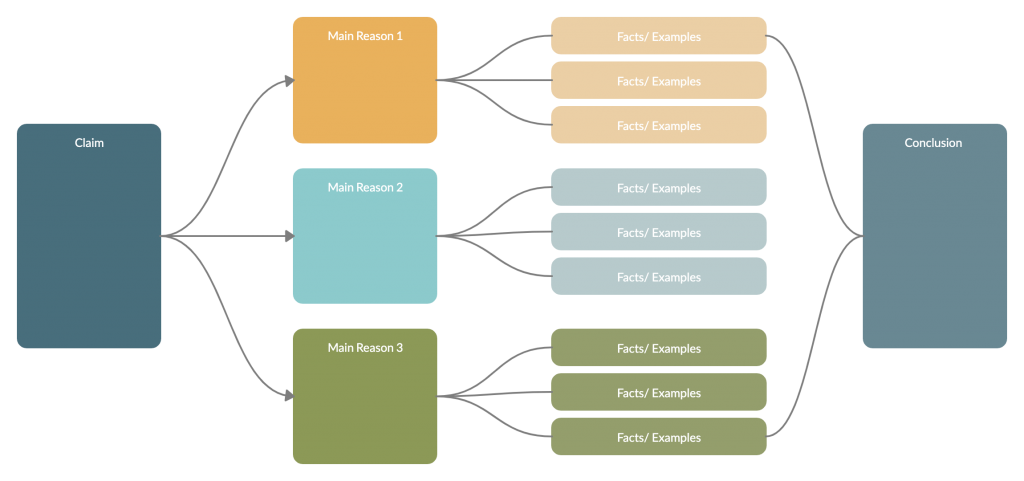
2. Sequence Chart
A sequence graphic organizer is a tool that helps visualize the order of steps of a process or a timeline of events, etc. It can also be used for note-taking, lesson planning, and essay writing.
Step 1: Identify the steps in the process or event.
Step 2: Using a sequence chart arrange these steps in sequential order.
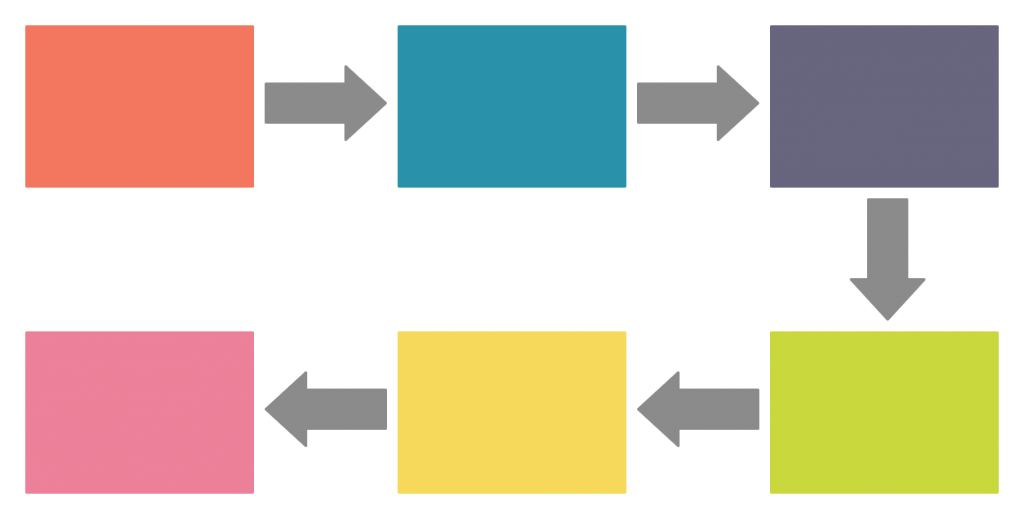
Graphic Organizers for Reading
3. story map.
A story map can be used to identify the different elements such as characters, character plots, themes, techniques, etc. in a book students are reading. It’s a useful tool that teachers can integrate into the lesson to improve students’ comprehension.
Step 1: Read the book and understand it well.
Step 2: Discuss the different significant elements that were involved in the story. These could be the characters, setting, problem and solution, etc. You can fill the story map during the discussion.
Step 3: Once the map is complete you can discuss each element individually.
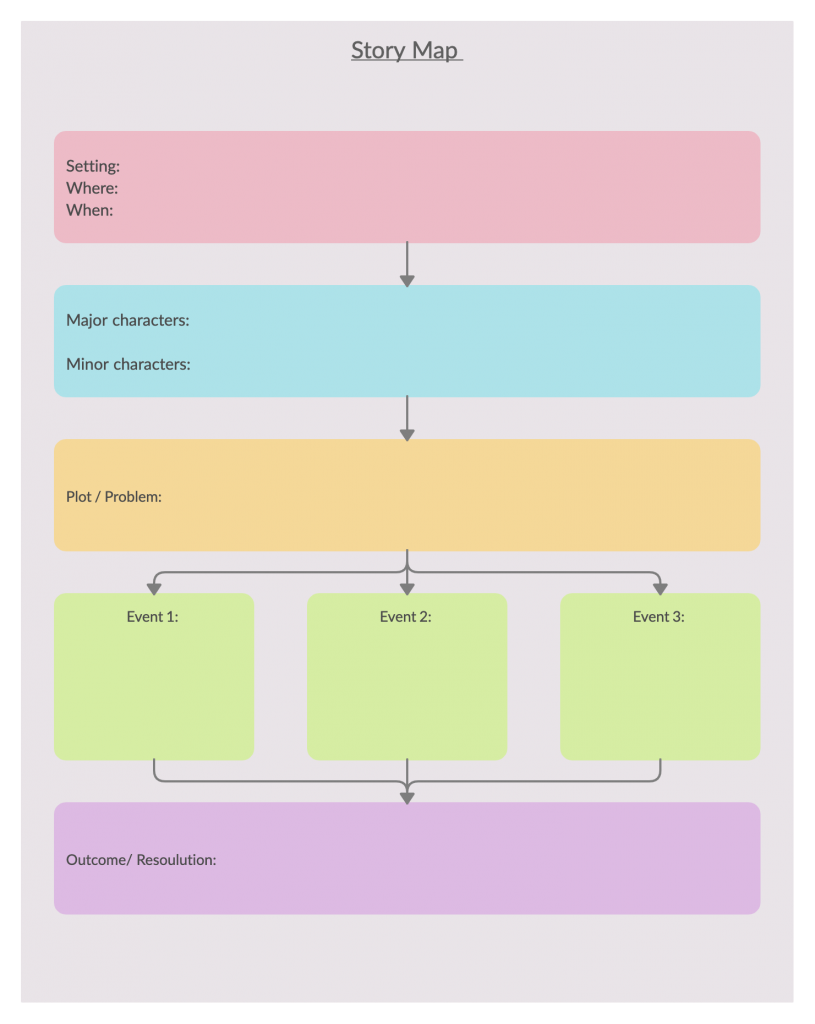
4. Biography graphic organizer
This is a tool that assists with understanding a character from a novel, autobiography or movie or a historical figure more in-depth. It brings attention to various important factors about a person’s life.
How to create it
Step 1: Gather as much information you can about the character you are studying. You can also refer to online resources, or ask from teachers or experts.
Step 2: As you analyze the information you have gathered, isolate the facts that stand out or you think are important.
Step 3: Use your biography graphic organizer to lay out the information in a presentable way. You can add images to make it more comprehensible as well.
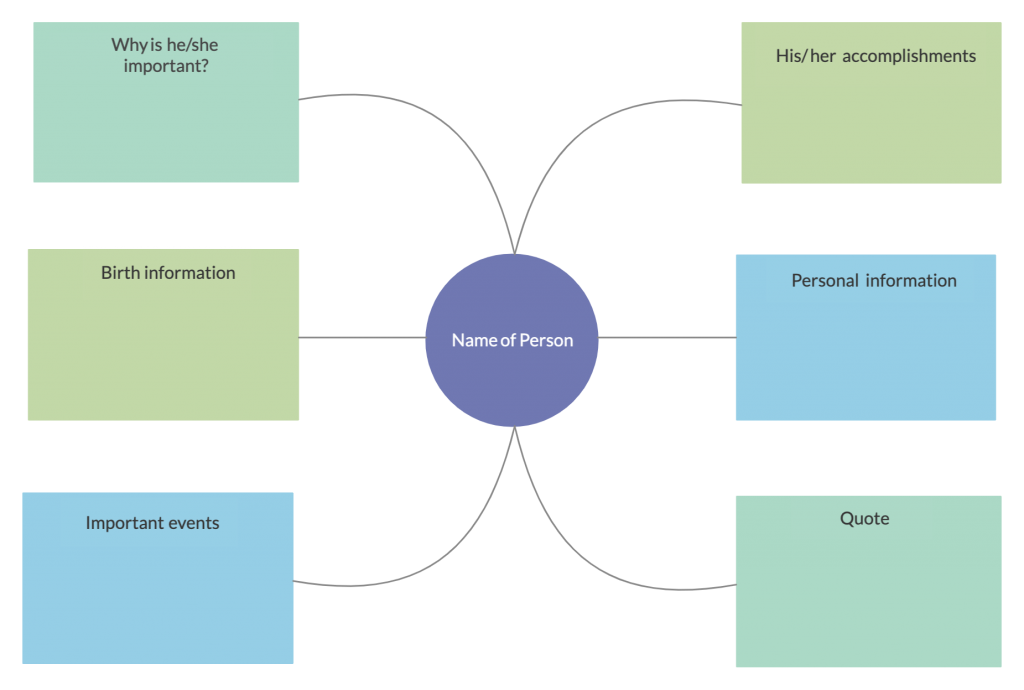
5. KWL chart
KWL chart is used for gathering information from student’s prior knowledge or experience. This 3 column chart captures the before (what the reader already knows), during (what the reader wants to learn) and after (what the reader learned) stages of reading.
Step 1: Get students to brainstorm around the selected topic and write down everything they know about it in the K column.
Step 2: Ask them to generate a list of questions about what they want to know in the W column of the chart.
Step 3: During or after reading the book/ lesson get them to answer these questions in the L column.

Graphic Organizers for Teaching
6. learning map.
Learning maps visually depict the key takeaways – skills, ideas, knowledge – students should get from a lesson. It usually provides a high-level view of the lesson/ unit/ course that is to be studied and the connection between its different components. Students can also use learning maps in the classroom for note-taking.
Step 1: At the center of the map, write down the topic (i.e. name of the lesson or unit)
Step 2: Brainstorm ideas and information related to it. Write these down on branches emerging from the center. Make sure that you place them in a way that makes sense to teach or in a logical sequence around the center.
Step 3: Add connectors between these elements and add labels to highlight the kind of relationship between them.

7. Analogy graphic organizer
The analogy graphic organizer uses analogy to help students identify similarities and differences between a new topic and a topic that they are already familiar with.
Step 1: Select a topic/ concept that the students already know and is analogous in certain aspects to the new topic
Step 2: Introduce the new concept and get the students to read and discuss it
Step 3: Using an analogy graphic organizer, ask the students to brainstorm and write similarities and differences between the two topics.
Step 4: Based on the completed graphic organizer, ask the students to write a brief description of the new topic

Analogy Graphic Organizer (Click on the template to edit it online)
8. Vocabulary graphic organizer
This tool can be used to assess the vocabulary knowledge of students. You can create graphic organizers including various elements to help students learn new words, and learn antonyms and synonyms.
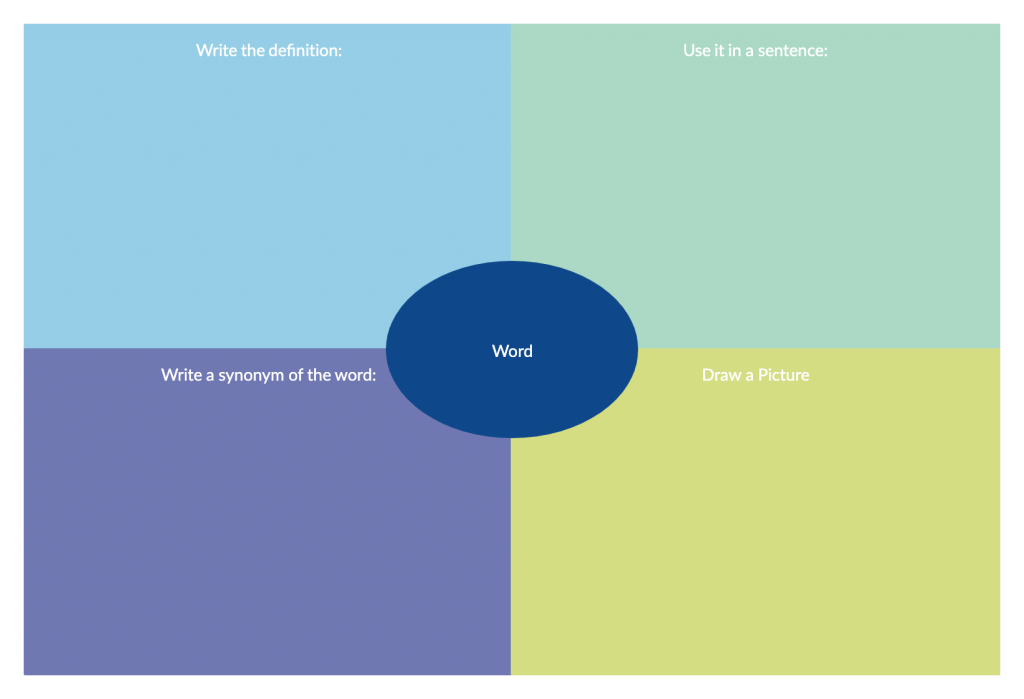
9. Problem-solving organizer
Problem-solving graphic organizers can be used to improve the problem-solving skills of the students. It helps students identify and evaluate solutions to problems.
Step 1: Identify the problem and write it in the problem box
Step 2: Ask students to then write down why they think it is a problem in the first place
Step 3: Get them to brainstorm all possible solutions along with the pros and cons relates to them.
Step 4: Once they select the best possible solution, ask them to list down all its possible consequences
Step 5: Students can then make suggestions to improve the selected solution further

10. Math Graphic Organizer
Math graphic organizers are used to describe math concepts graphically to students. It helps with simplifying and solving complex math problems.
Step 1: Select the math problem you want to identify and a relevant graphic organizer that you can use to solve it.
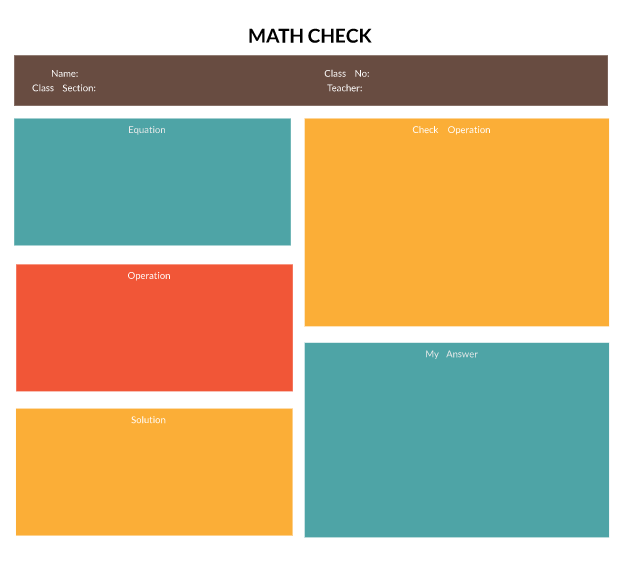
Graphic Organizers for Learning
11. timeline graphic organizer.
Timeline diagrams are a type of graphic organizer that shows a sequence of events in chronological order.
They come in handy when studying history as you can use it to display major historical events that occurred during a period of time along with important details such as dates and locations in which they took place.
In addition, timeline charts can also be used to show the progress of something (i.e. growth of a business) or changes.
Step 1: Identify the different events and the sequence of order in which they took place.
Step 2: Use a research on your target audience to arrange them chronologically
Step 3: Include significant details such as dates, locations and other additional information as needed.

12. T chart
T charts allow students to study two facets of a topic. For example, disadvantages and advantages, pros and cons, differences and similarities, etc.
Step 1: Draw a T chart and write down the two areas you want to brainstorm around on each column head.
Step 2: Write down facts on each column as you carry out your brainstorming.
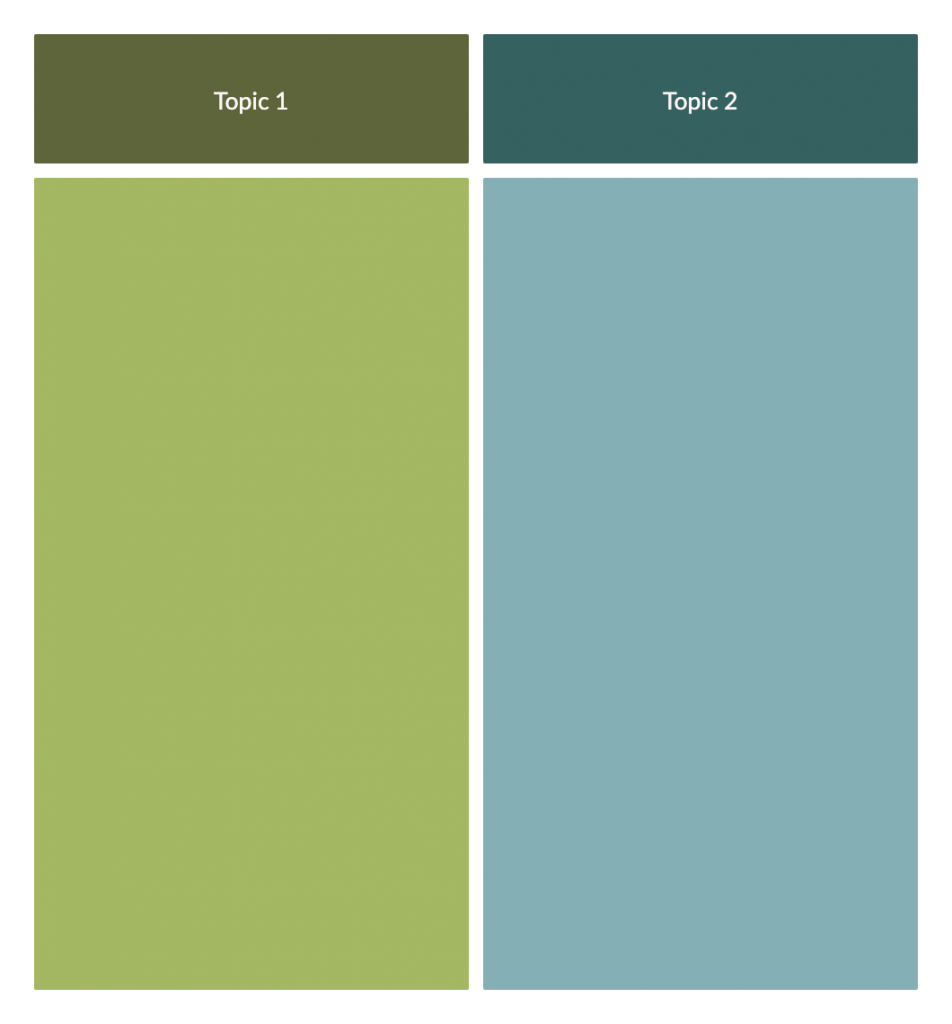
13. Hierarchy chart
Hierarchy charts visualize the elements of a system, organization or concept from its highest position to the lowest. Students can use this tool to understand the superordinate and subordinate categories of a topic and the relationship between them.
Step 1: Identify the most important element under the topic you are studying. Write this down at the top of the hierarchy chart.
Step 2: List down the second layer of sub-elements stemming from the first component you have identified. Add a third and fourth as necessary.
Step 3: Connect these with lines to show how they are connected to each other.

14. Star diagram
Star diagrams are used to organize the characteristics of a chosen topic. It can also be used to brainstorm around new topics.
Step 1: Select the topic you want to study and write it down in the center of the star diagram .
Step 2: Write down the characteristics or attributes related to the central topics on each point of the star. Adjust the points of the star depending on how many traits you write down.
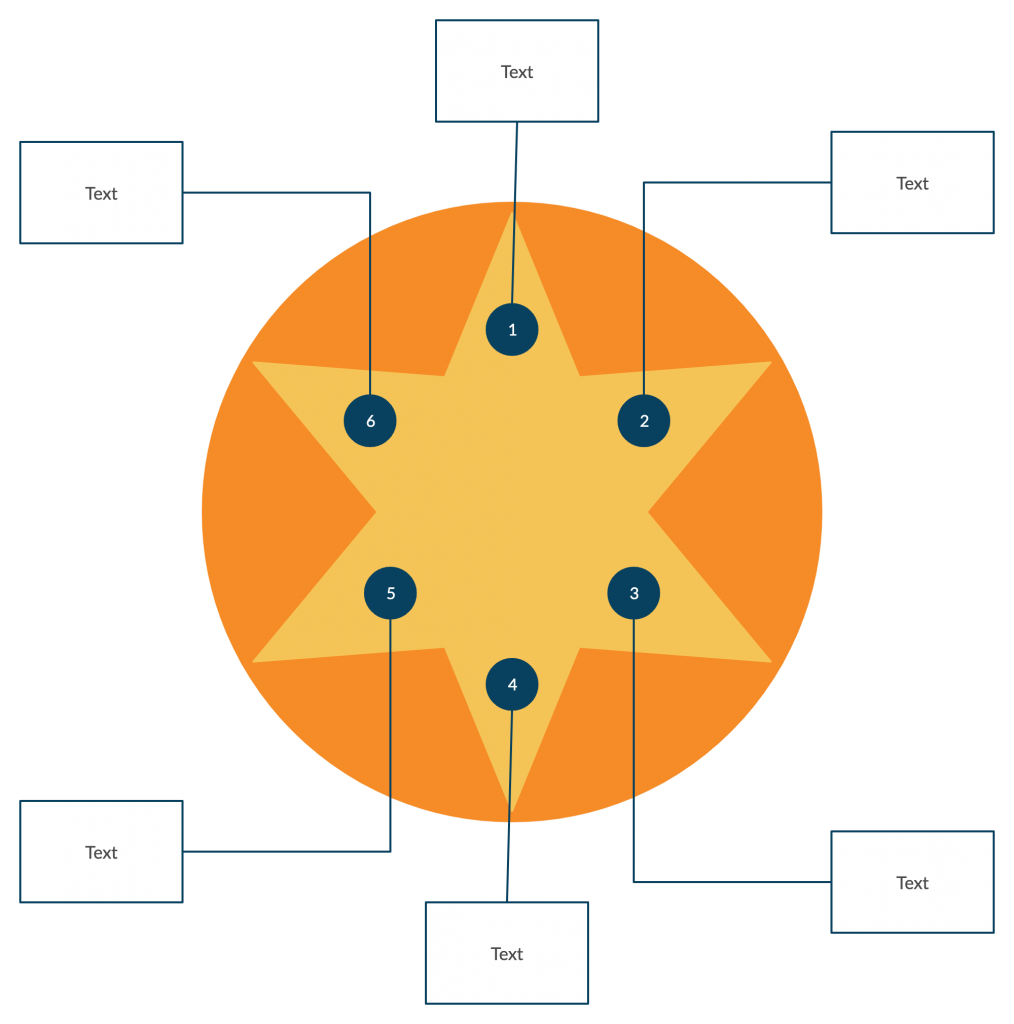
Graphic Organizers for Brainstorming
15. cluster diagram.
Cluster diagrams can be used to facilitate a brainstorming session or structure idea generation and even to help with exploring new topics.
Step 1: Pick your topic of interest to explore. This should be placed in the middle of the diagram.
Step 2: Brainstorm around this main idea and come up with sub-topics related to it. Place them around the center.
Step 3: Brainstorm around each of the sub-topics and write down related ideas around them.
Step 4: Add as many layers as you want. However, use color-coding to emphasize each branch of thought. This will make it easier for you to read and understand the cluster diagram .

16. Lotus diagram
Lotus diagram is an analytical tool that can be used to breakdown broader and more complex topics into smaller components for easy understanding. It can be used for brainstorming and studying new topics.
Step 1: Draw a 3×3 grid in the center. On the square in the center, write down the main topic to be explored.
Step 2: Write down the related sub-topics around it as you brainstorm.
Step 3: Draw 8 more 3×3 grids around the one in the center. Each of these can be used to write down facts that you brainstorm around each subtopic.
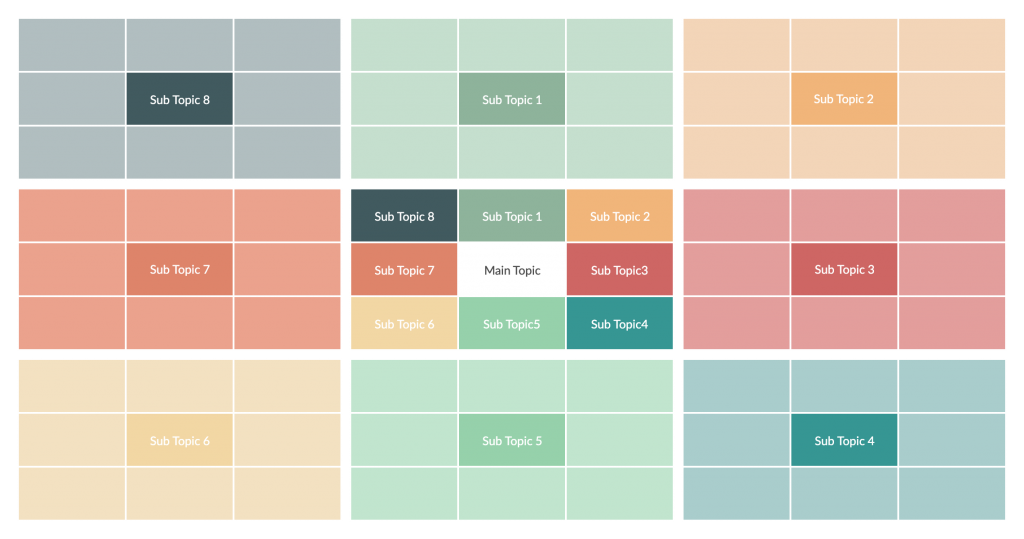
17. Cause and effect graphic organizer
This type of graphic organizer shows the causes and effects of an event. The cause is the reason why something has happened, and effect is the result of what has happened. Visualization helps clearly understand the different cause and effect relationships.
Using a cause and effect graphic organizer , identify the causes and effects related to the problem you are studying or writing about. There could be several models of cause and effect events, such as one cause leading to one effect or multiple effects, or multiple causes leading to one effect or multiple effects.
- One cause leading to several effects
- Several causes leading to one effect (You can use a fishbone diagram here)
- Each cause having one related effect
- One cause triggering another cause that leads to another

18. Mind map
A mind map is a tool that helps capture the free flow of thought and is widely used for brainstorming around topics. Additionally, it can also be used to organize and group information about a topic.
Step 1: Write down the topic you are brainstorming around in the center.
Step 2: On branches emerging from the middle, write down brainstormed ideas/ thoughts.
Step 3: Expand each sub idea with more facts. You can keep on adding more information to your mind map until you have enough.

Graphic Organizers for Compare and Contrast
Here we have listed 19 types of graphic organizers for teaching and learning. Based on their varied purposes, you can utilize them in reading, writing, researching, brainstorming, and analyzing. Best of all you can use our Compare and Contrast Chart Maker to draw them.
19. Double bubble map
The double bubble map is one of the popular thinking maps. It is much like a Venn diagram and is used to identify similar and different qualities between two things.
How to use it?
Step 1: Write down the two ideas/ topics you are comparing in the two bubbles in the center.
Step 2: As you brainstorm and analyze the topic, write down the differences in the bubbles radiating from the center.
Step 3: Write down the similarities in the bubbles that are common to both topics.

20. Venn diagram
Another graphic organizer that helps you visually represent a comparison of differences and similarities between two subjects, is the Venn diagram. What makes it different from the is that it can include more than two topics and one common area.
It works similar to the double bubble map.
Step 1: Write down the topics being compared on the top of each circle.
Step 2: Writ down the differences or unique characteristics inside its own sector avoiding the overlapping area.
Step 3: List the similarities in the common area.
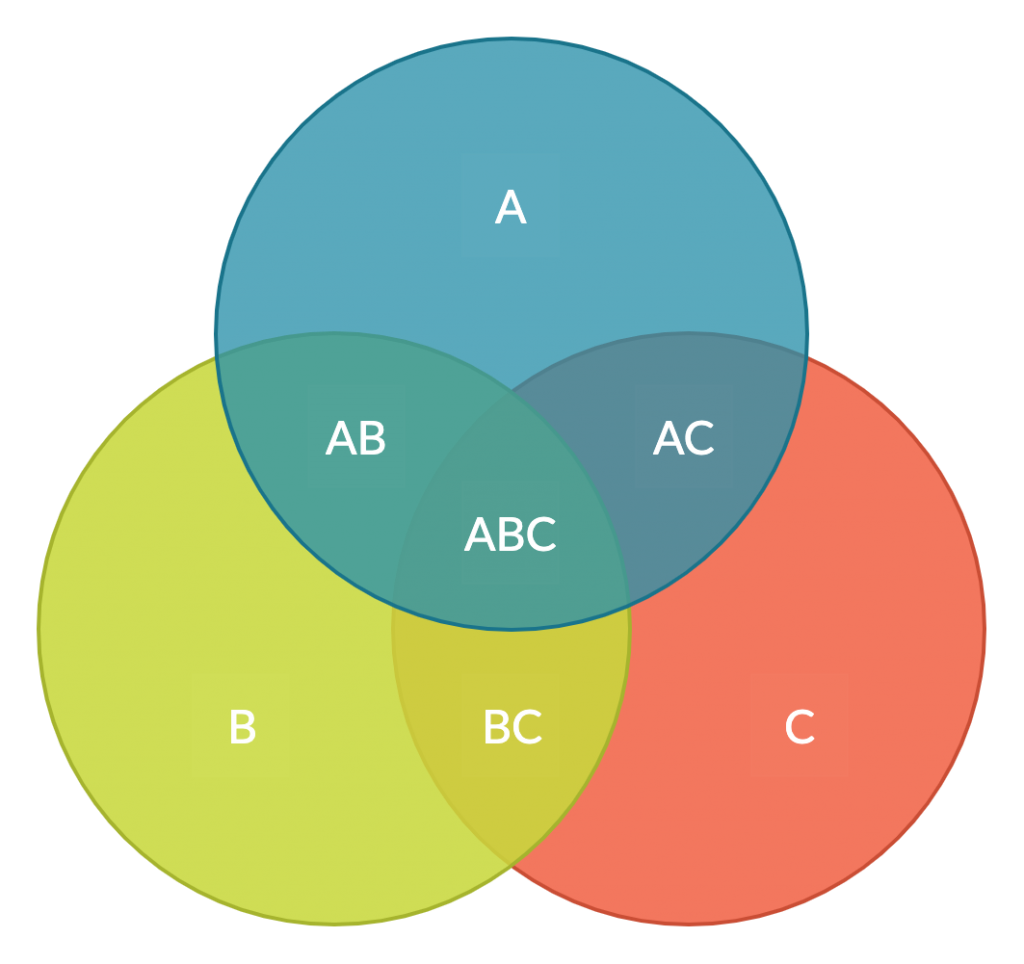
Add to Our List of Graphic Organizers for Teachers and Students
Although we have covered 19 types of graphic organizers in this post, there are plenty more that can be useful to our users. Know more? Mention in the comments section below to keep expanding the list of ultimate graphic organizers.
FAQs About list of Graphic Organizer
When selecting a graphic organizer for a specific project, you should consider the type of information you need to organize and the purpose of the project. Here are some tips on how to select the right graphic organizer:
Identify the type of information: Before selecting a graphic organizer, consider the type of information you need to organize.
Determine the purpose of the project: Consider the purpose of the project and what you want to achieve.
Consider the audience: Think about who the audience is for the project. If the audience is young children, a simpler graphic organizer like a picture web might be more appropriate. If the audience is adults, a more complex graphic organizer like a timeline or a chart could be suitable.
Evaluate the effectiveness of different graphic organizers: Try out different graphic organizers and see which ones work best for you. Creately has different graphic organizer editable templates that you could use to create your graphic organizer based on the purpose.
Be creative: Don’t be afraid to create your own graphic organizer or adapt an existing one to meet your needs. Graphic organizers are flexible tools that can be customized to fit different projects and purposes.
Avoid these common mistakes that you make to ensure that your organizer is effective in conveying information.
Avoid overcomplicating the design of your graphic organizer: It should be easy to read and understand, therefore avoid using too many colors, fonts, or shapes which make the organizer confusing and difficult to read.
Consistency is important in creating a graphic organizer. Use the same formatting, color scheme, and font throughout the organizer to ensure that it is easy to follow and understand.
The purpose of a graphic organizer is to simplify and organize information. Including too much information can defeat the purpose and make the organizer overwhelming. Stick to the most important information and use the organizer to highlight key concepts and relationships.
Use clear and appropriate labels for each section of the organizer. Avoid using labels that are too vague or unclear, as this can cause confusion and make it difficult to understand the relationships between the different elements.
Consider who the audience is for the graphic organizer and use appropriate language and images. Avoid using jargon or technical terms that may not be familiar to the audience.
Test your graphic organizer to ensure that it effectively conveys the intended information. Ask for feedback from others and make revisions as needed.
Join over thousands of organizations that use Creately to brainstorm, plan, analyze, and execute their projects successfully.
More Related Articles

Amanda Athuraliya is the communication specialist/content writer at Creately, online diagramming and collaboration tool. She is an avid reader, a budding writer and a passionate researcher who loves to write about all kinds of topics.
Compare & Contrast Map
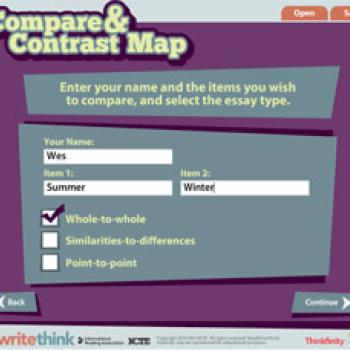
About this Interactive
Related resources.
This interactive graphic organizer helps students develop an outline for one of three types of comparison essays: whole-to-whole, similarities-to-differences, or point-to-point. A link in the introduction to the Comparison and Contrast Guide give students the chance to get definitions and look at examples before they begin working. The tool offers multiple ways to navigate information including a graphic on the right that allows students to move around the map without having to work in a linear fashion. The finished map can be saved, e-mailed, or printed.
- Student Interactives
- Lesson Plans
The Persuasion Map is an interactive graphic organizer that enables students to map out their arguments for a persuasive essay or debate.
The Essay Map is an interactive graphic organizer that enables students to organize and outline their ideas for an informational, definitional, or descriptive essay.
This interactive tool allows students to create Venn diagrams that contain two or three overlapping circles, enabling them to organize their information logically.
Students explore picture books to identify the characteristics of four types of conflict. They then write about a conflict they have experienced and compare it to a conflict from literature.
- Print this resource
Explore Resources by Grade
- Kindergarten K
What is a graphic organizer and how to create one?

TABLE OF CONTENTS
Organizing your thoughts and ideas isn't always easy – especially when working with complex topics, piles of information, or collaborative projects.
Use a graphic organizer tool is one of the easiest and most effective ways to organize ideas, list information, and identify trends visually. Using diagrams and visual aids has helped marketers, IT professionals, teachers, and just about anyone to convey complex ideas simply.
In this article, we'll cover the basics of graphic organizers, their types, use cases, and how to make one of your own. Read on to get started.
What is a graphic organizer?
Do you remember the last time you felt inspired and full of ideas? It's an exhilarating feeling, but it can also be overwhelming when trying to organize all the thoughts running wild through your mind.
That's where graphic organizers come in.
These visual tools help harness those complex concepts into a simple visual representation, such as a diagram or graph, that’s easy to understand.
Think of it like a map that connects and organizes your thoughts and ideas in a clear and structured path so that you can see how all the pieces fit together. These tools make it easier to see the big picture and identify connections between concepts that may have otherwise gone unnoticed.
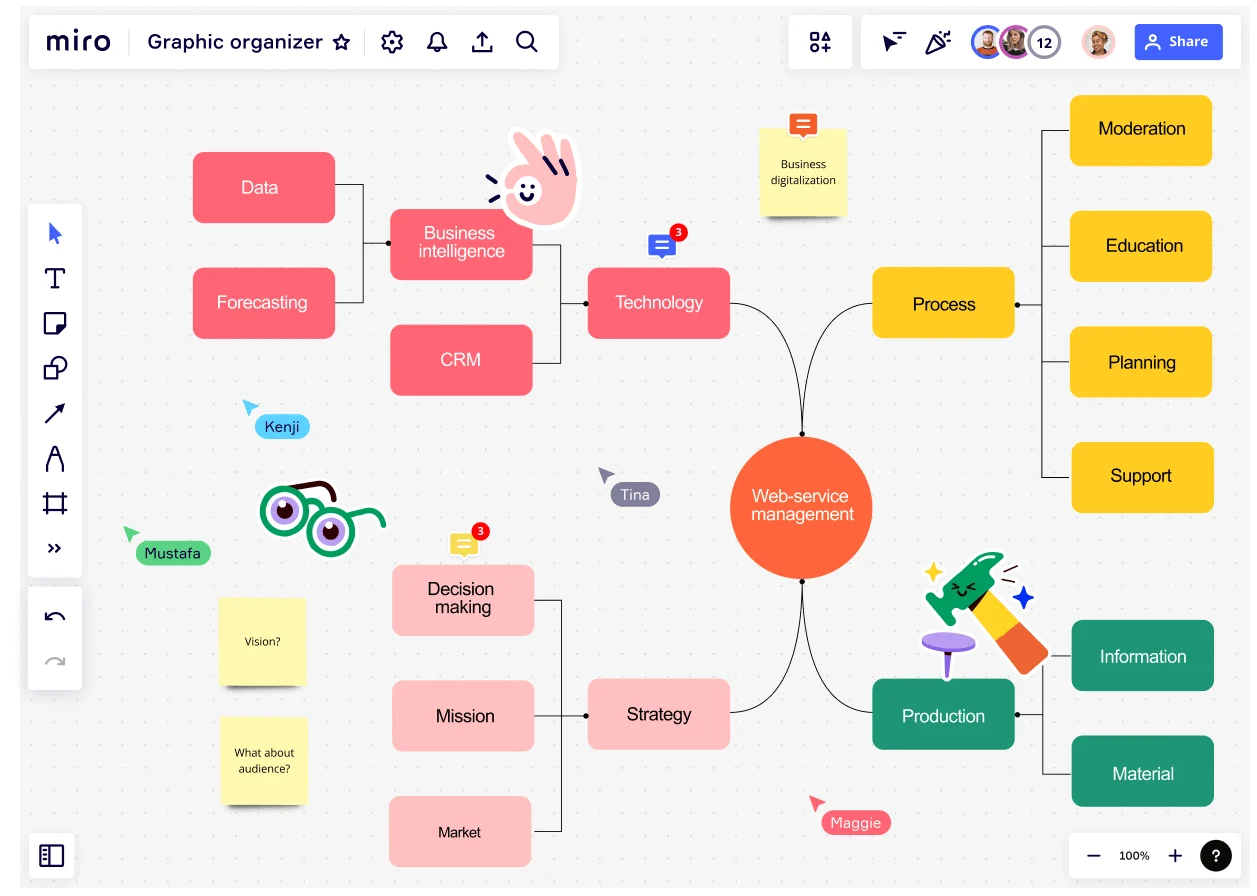
In a collaborative environment, using graphic organizers can greatly enhance communication and teamwork. It's easier for team members to align on project goals and contribute their own insights when there's a visual representation of the ideas and information discussed. As a result, teams have constructive discussions that lead to more brilliant ideas.
Also, with digital collaborative workspaces like Miro, you can even use graphic organizers to collaborate remotely. Team members can brainstorm, organize, and work together from anywhere around the world in one shared space.
You can also treat a graphic organizer like a compass that helps you navigate a sea of information. It guides you towards a clearer path using visual aids so that you or your team can make informed decisions and ride a wave of productivity. But with all that said, how exactly can you put one to use?
Suppose a company that produces and sells handmade soap hasn't been doing well in sales in the last quarter. The marketing team needs help to identify the root cause. The project analyst on the team decides to use a graphic organizer to help analyze the problem and creates a diagram with potential causes, such as pricing, quality, and marketing strategy. Each category is then broken down into subcategories with specific details like customer reviews and competitors’ pricing.
Through this process, the analyst noticed key areas that needed improvement. For example, they noticed that the company’s pricing is significantly higher than competitors, and customer reviews mention that the new packaging makes it hard to understand product benefits.
With this information organized and visually presented, the analyst can present clear, data-driven information to the marketing team to improve sales. The team can then address these issues and track the changes made using the same graphic organizer.
Now that you’ve seen a practical example of applying one, we’ll explore ten types of graphic organizers used in various personal and professional situations.
10 types of graphic organizers
Take a look at how these graphic organizers can help you organize information, analyze problems, and spark new ideas.
1. Venn diagram
A Venn diagram is a popular graphic organizer that compares and contrasts different topics or datasets using interlocking circles. It shows the similarities and differences between these topics so you can better understand their relationships and connections. The overlapping area in the middle of the circles indicates the similarities, while the separate circles highlight the differences between each.
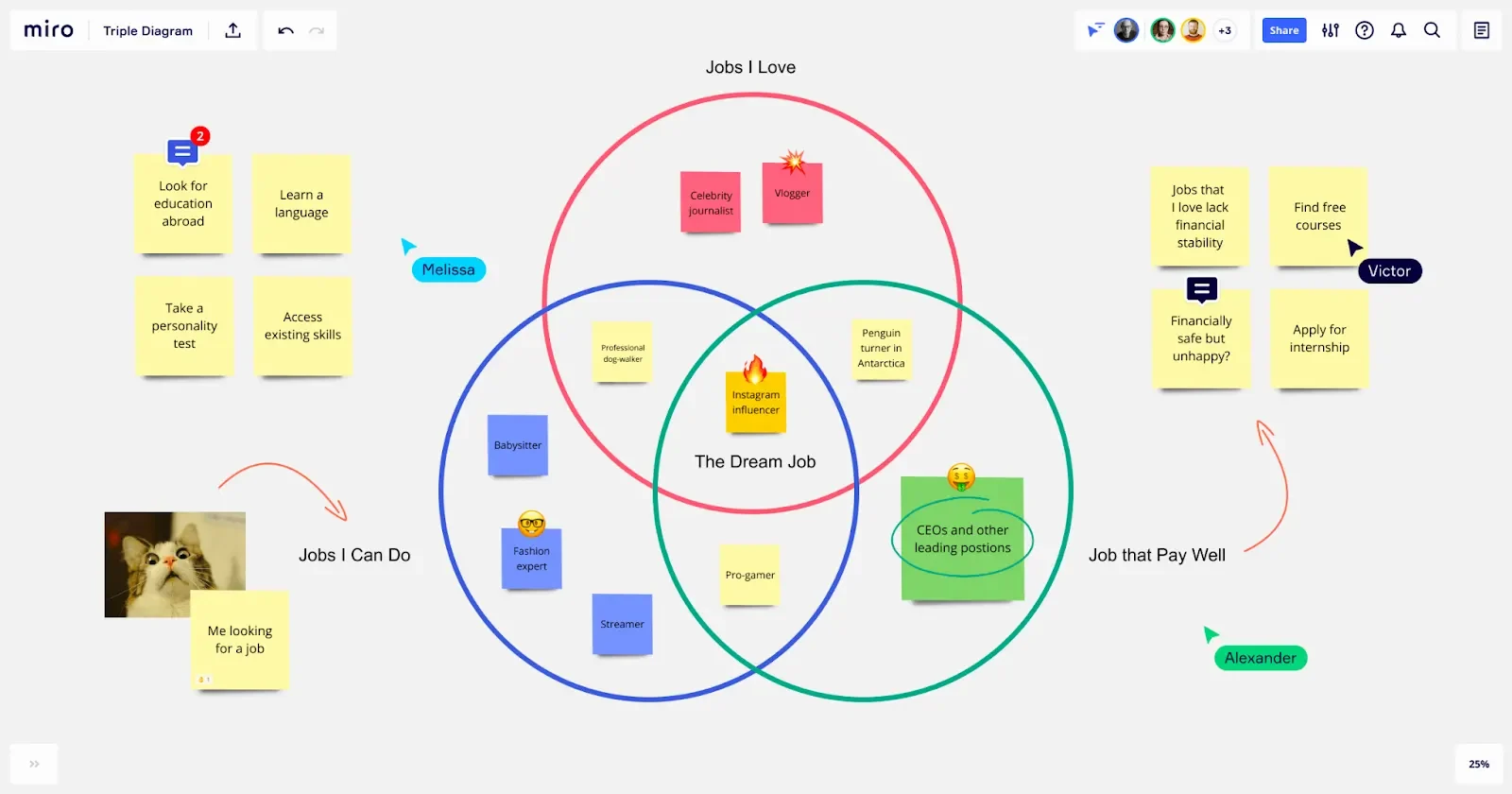
Use a triple Venn diagram template to compare three different subjects.
2. Tree chart
Like its name, a tree chart is a graphic organizer that shows information in the structure of a tree, with the main topic at the top of the chart and subtopics branching off it. These charts are especially useful for organizing information in a hierarchical structure. For example, when breaking down a group project into smaller manageable items to delegate to the team.
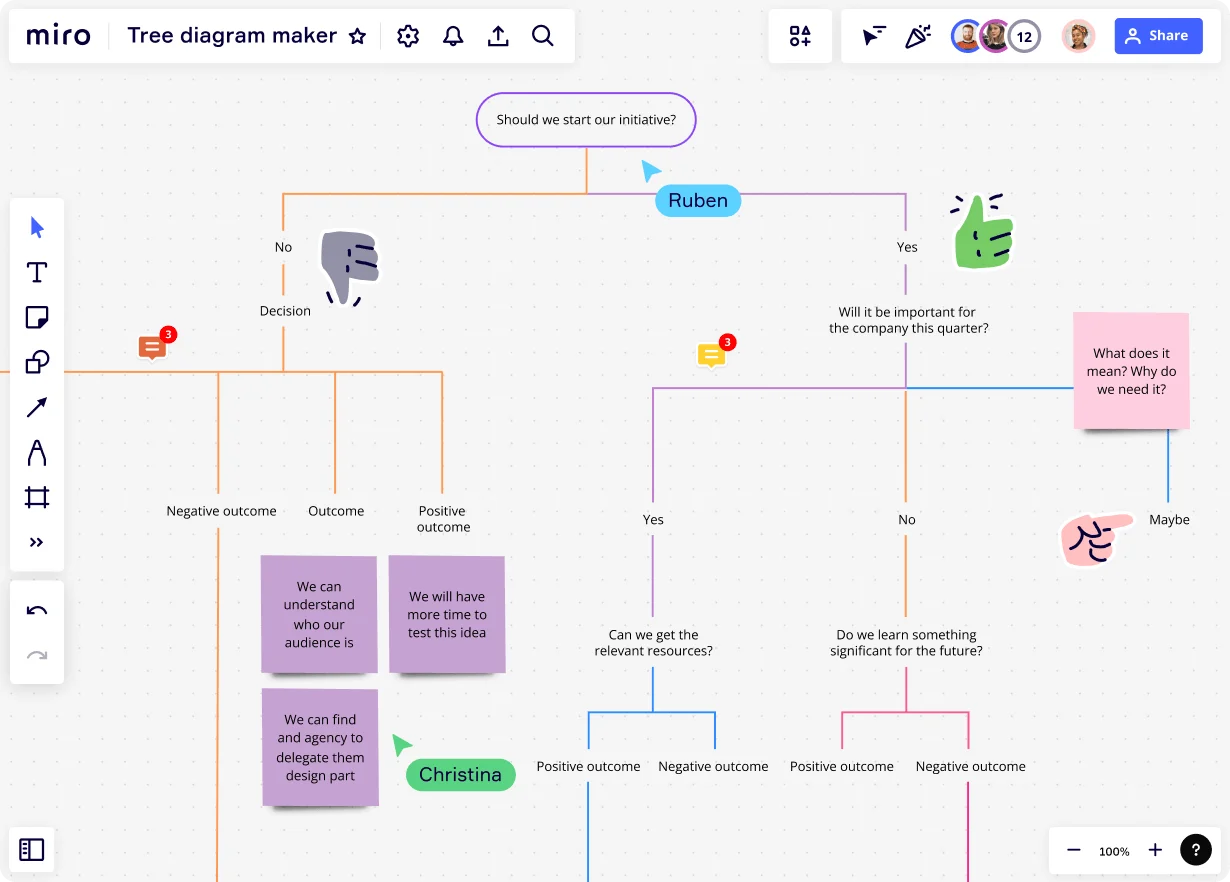
Use a tree chart maker to track objectives and results with a hierarchical structure.
3. Cause and effect chart
You can easily see the connections between actions and results with a cause and effect chart. It’s a powerful tool for analyzing complex issues and identifying possible solutions. Breaking down complicated cause-and-effect relationships into bite-sized chunks helps you better understand how different factors interact and how to achieve your goals more accurately and precisely.
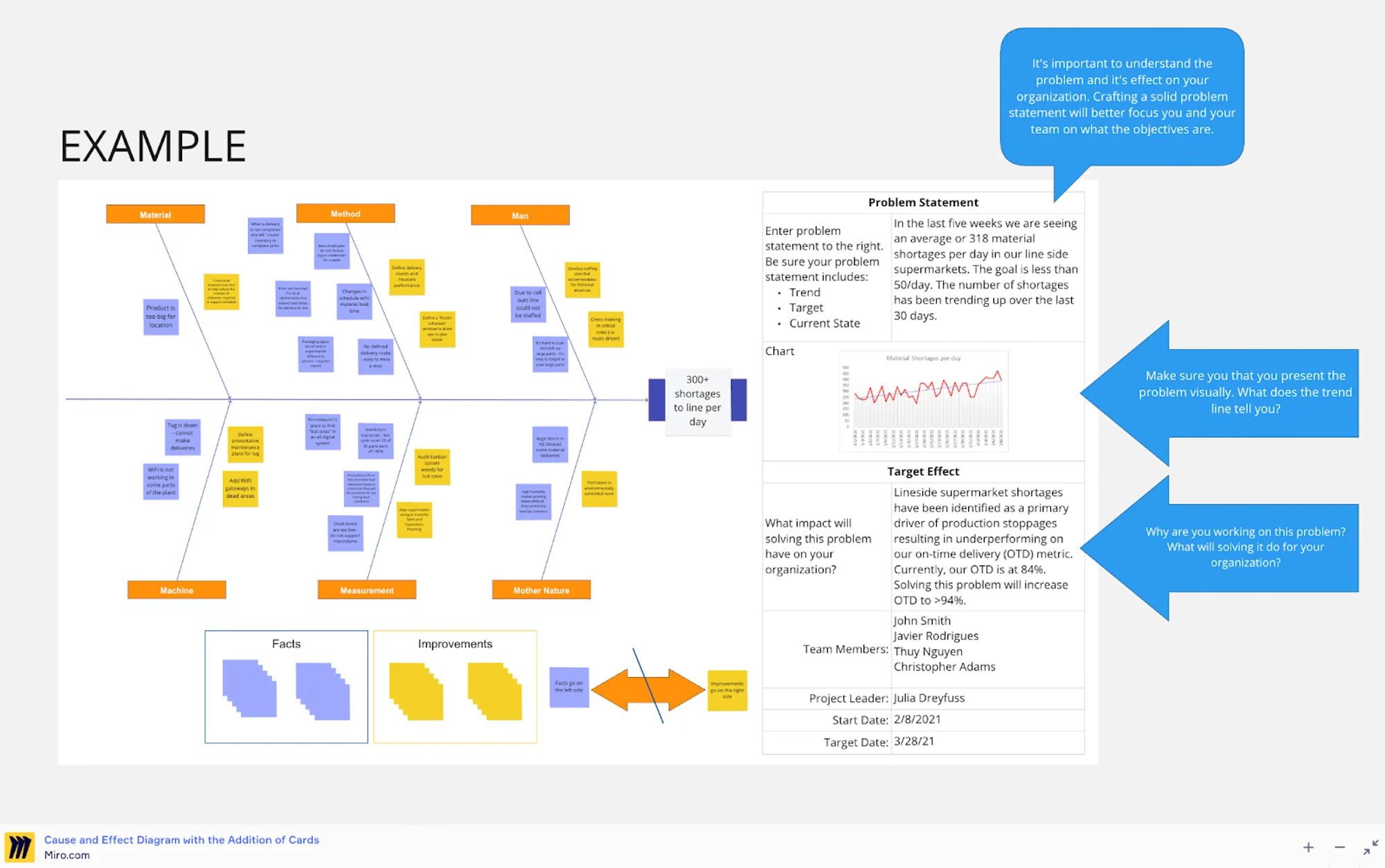
Pinpoint areas of improvement with a cause and effect chart .
4. Compare and contrast graph
Like a Venn diagram, a compare and contrast graph compares two or more things but in a more detailed and structured way. Instead of overlapping circles, you'll see tables or lists placed side by side to highlight the differences and similarities between the topics. This structure helps you quickly see how the topics relate to each other and identify key attributes from each topic.
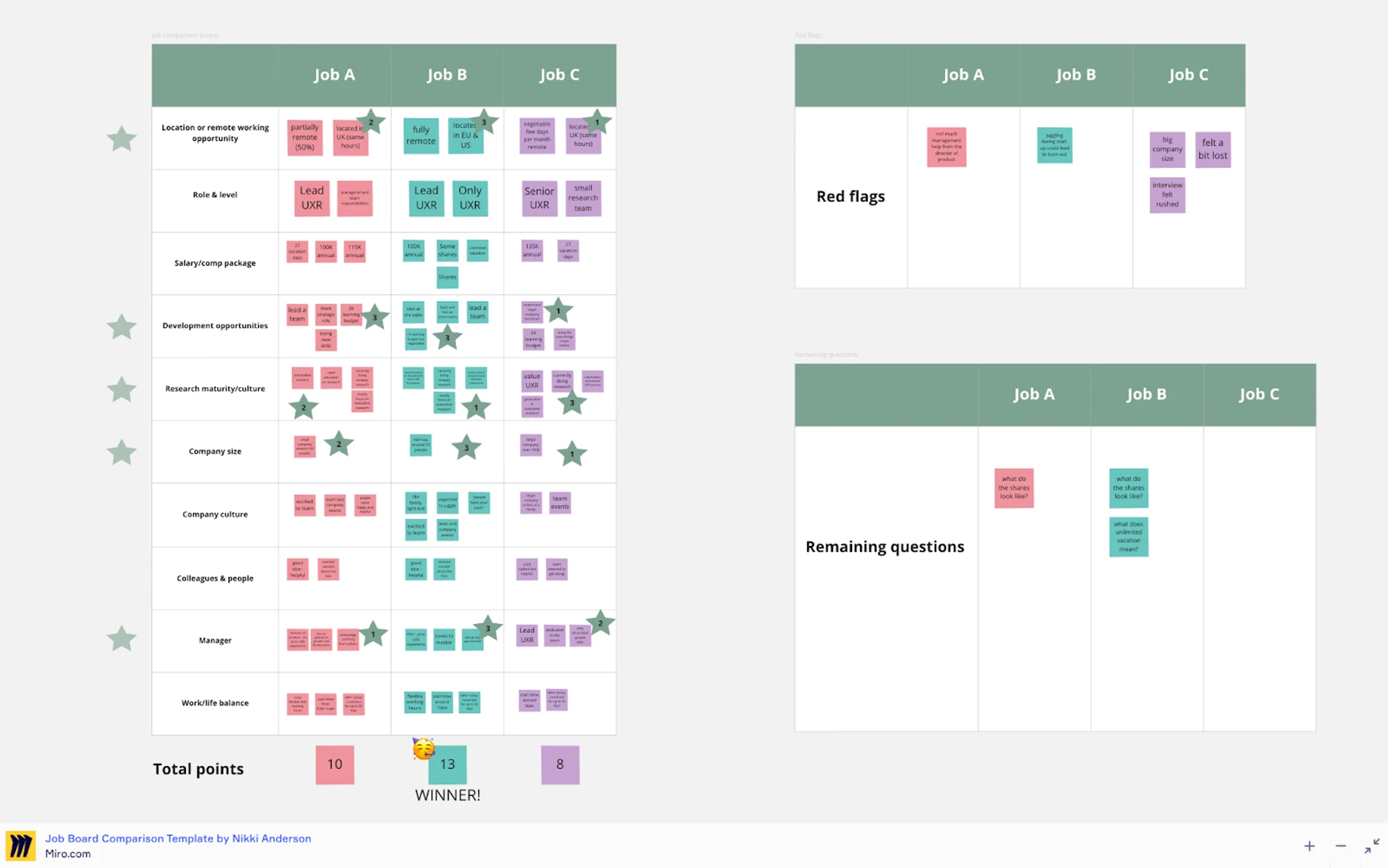
Analyze prospective jobs with a compare and contrast graph .
5. Story map
A story map, also known as a plot diagram , is a convenient tool for analyzing and understanding the elements of a story, including the plot, setting, characters, and themes. It includes a visual representation of a story’s arc, such as the introduction, climax, and resolution. This graphic organizer is a favorite of educators to help students unravel complex stories. Marketers also use this to craft compelling presentations or proposals that tell a story to engage their audience.

Stay focused on a writing project by story mapping it effortless.
7. Sequence of events chart
If you need to get a clear sense of the chronological order of an event or process, a sequence of events chart is your best bet. By dividing an event into key moments that follow a sequential order, this graphic organizer makes it easy to understand what happened and when. Though often used in educational settings, project managers or event planners rely on it to determine the sequence of activities for their projects or events.
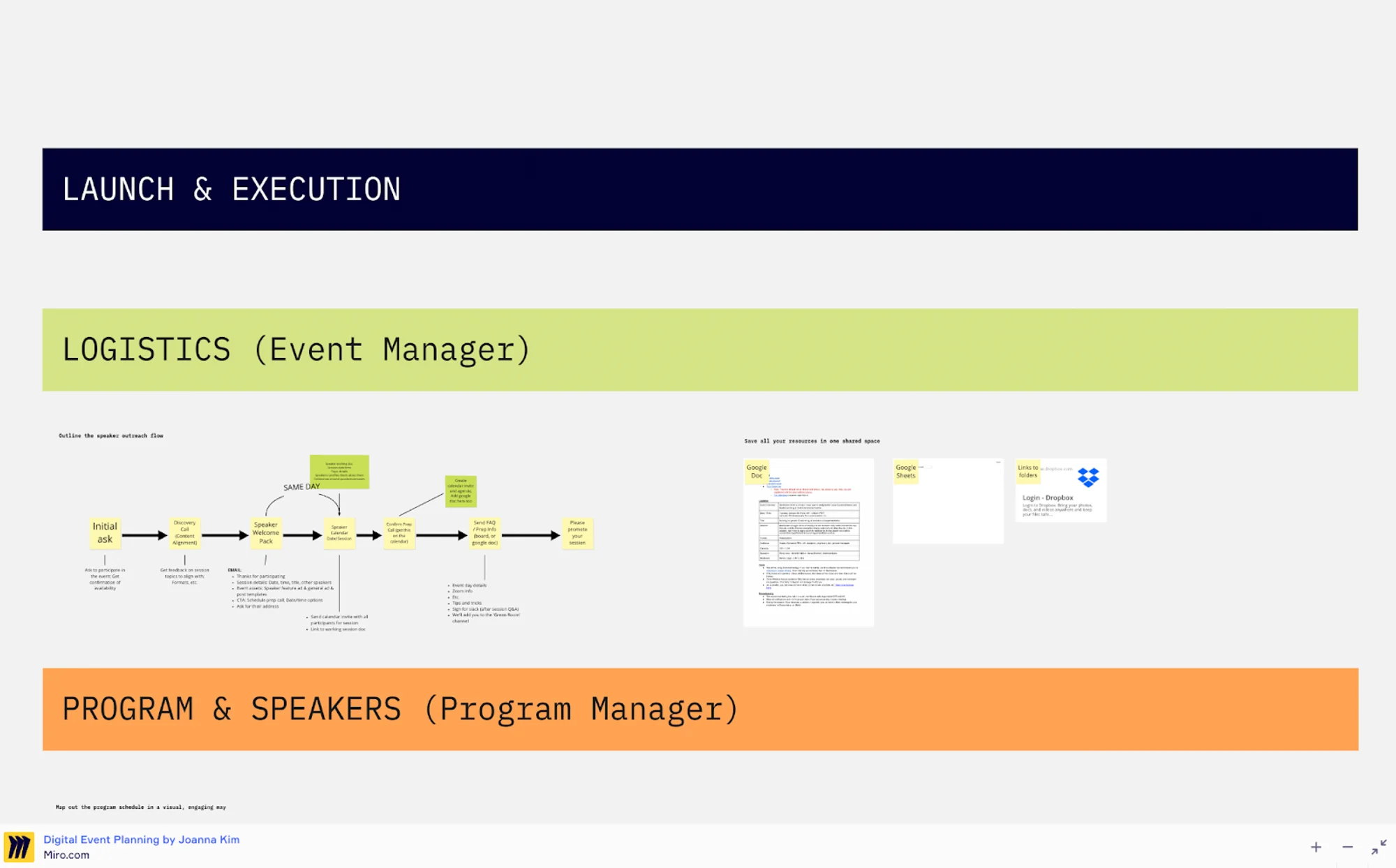
Clarify event logistics using a sequence chart .
8. Star diagram
A star diagram highlights key concepts by organizing related information around a central topic. It’s perfect for scenarios where you need to define a specific topic with detailed descriptions. For example, marketing teams can use this graphic organizer to define key selling features of a new product so they know what to promote. It’s also good for goal setting, with a goal in the center and actionable items in the arms of the star.
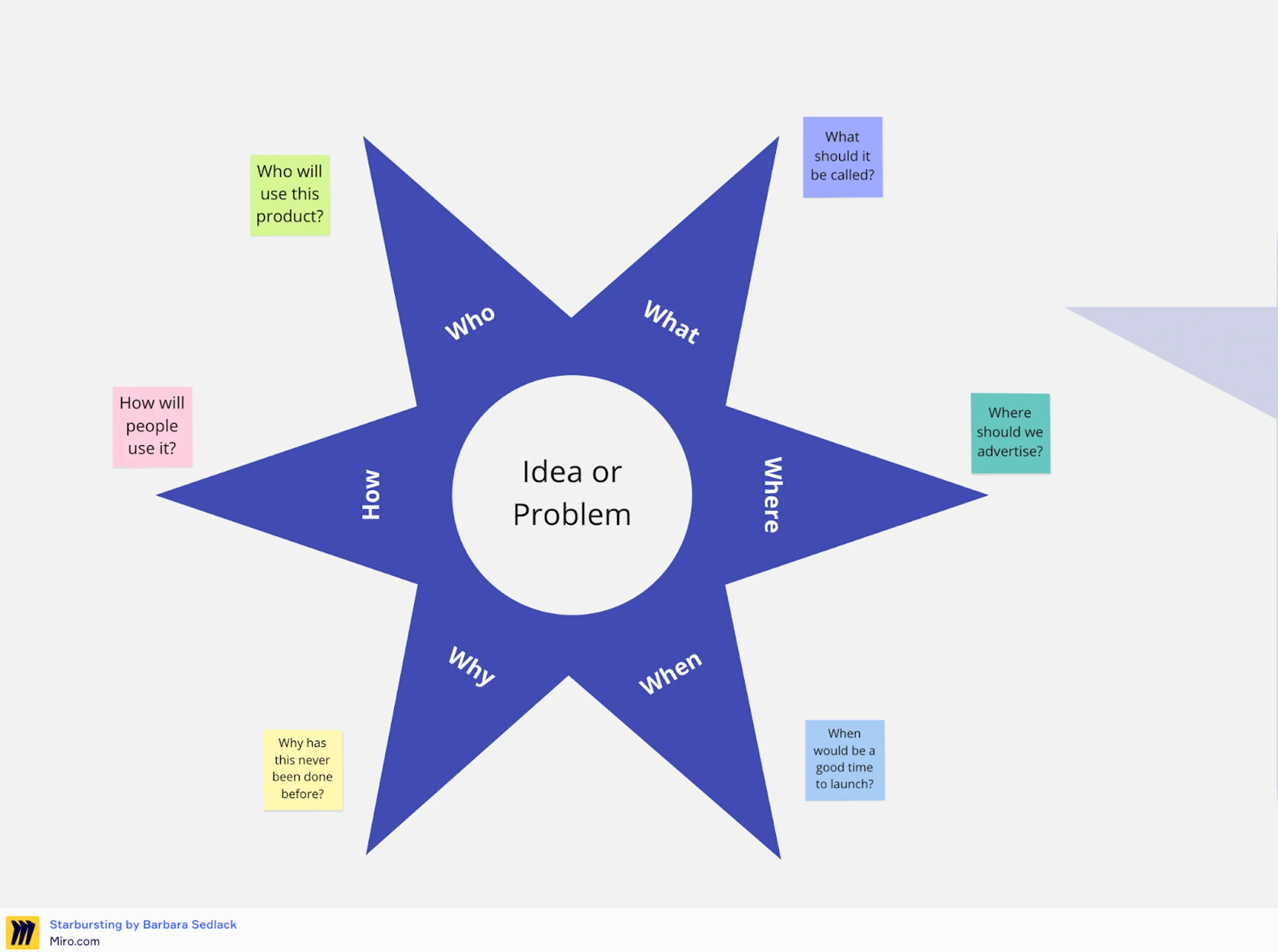
Define your problem in detail with a star diagram .
9. Circle map
A circle map is an effective visual tool for brainstorming and organizing ideas. A small circle inside a larger one allows for free-flowing thoughts to be connected to the central idea. Another variation is a concept map , with a main idea in the center and related information or subtopics surrounding it. This graphic organizer is your go-to for generating ideas, solving problems, and making connections between different concepts.
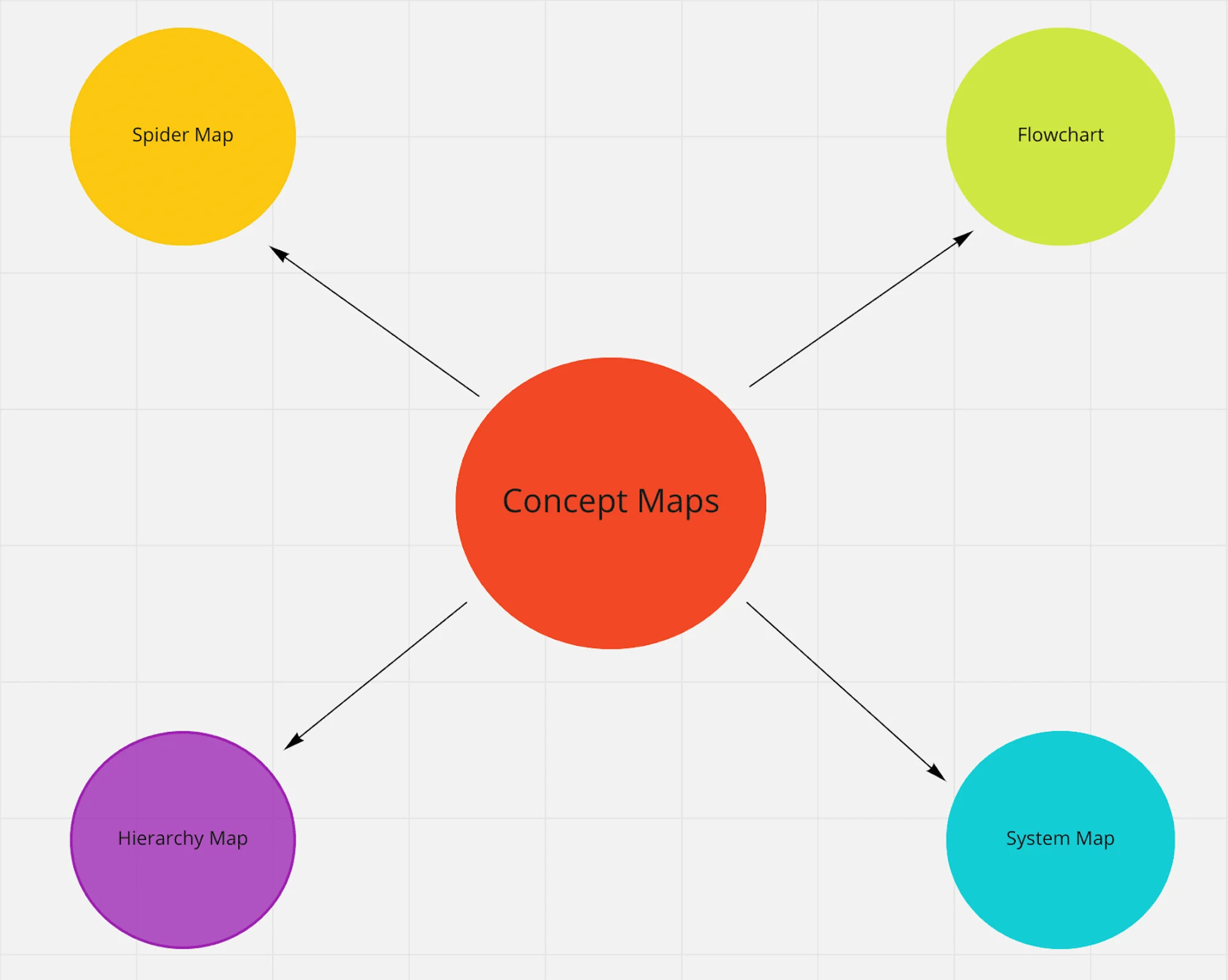
Boost creativity and generate ideas using a concept map maker .
10. Problem-solving chart
You can tackle complex and multi-layered issues with a problem-solving chart. A 5 Whys framework is a popular type of problem-solving chart. It's popular in business settings because it encourages critical and logical thinking and helps evaluate different options to choose the best solution. By dissecting a problem into smaller facets, it becomes easier to identify the root cause and possible solutions.
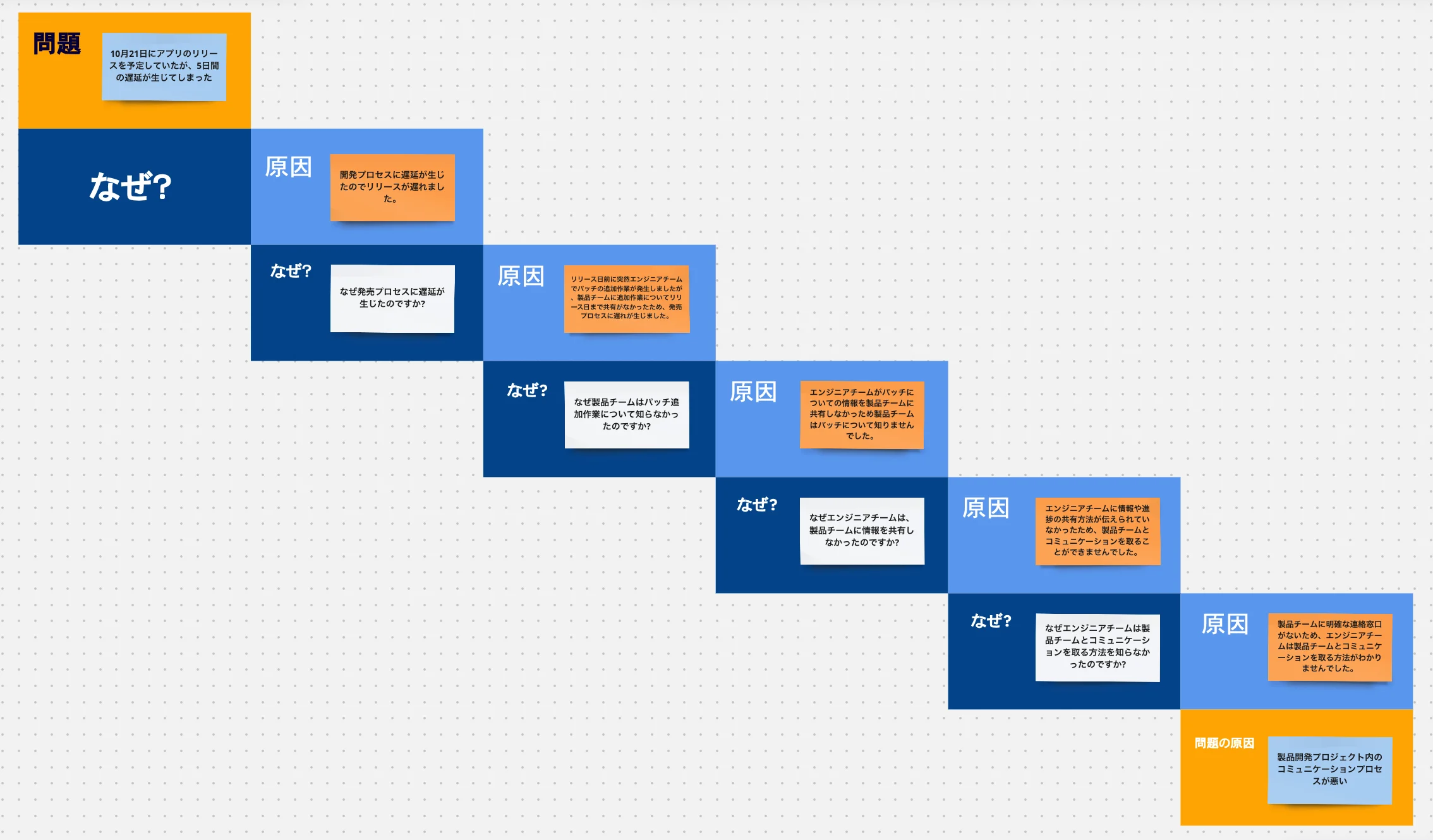
Get to the bottom of your problem with a 5 Whys problem solving chart .
Use cases for a graphic organizer
Look no further if you're wondering how these graphic organizers can be applied to your life or work. This section will explore how different people and professions can use graphic organizers to achieve their goals.
Marketing and Sales
The world of marketing and sales can be chaotic and overwhelming, but graphic organizers are a valuable tool for keeping things organized and on track. They also promote collaboration by letting teams share visuals and content in one place, making it convenient to view the big picture and expand on new ideas. A story map can help tell a compelling narrative about a product, while a star diagram can help identify and target specific audiences. Marketing and sales teams can stay creative, coordinated, and focused on achieving their goals.
IT and Technology
IT and Technology professionals have a lot of brainpower to share, and that's where graphic organizers shine. In an industry where data is everything, graphic organizers allow experts to visualize network topologies and other architecture quickly, saving time and improving communication with colleagues. They also make sharing concepts a breeze by finding the links between seemingly unrelated objects and ideas. Cause-and-effect charts and entity relationship diagrams are commonly used in the industry to identify the relationships between different events or actions that affect the performance of systems and networks.
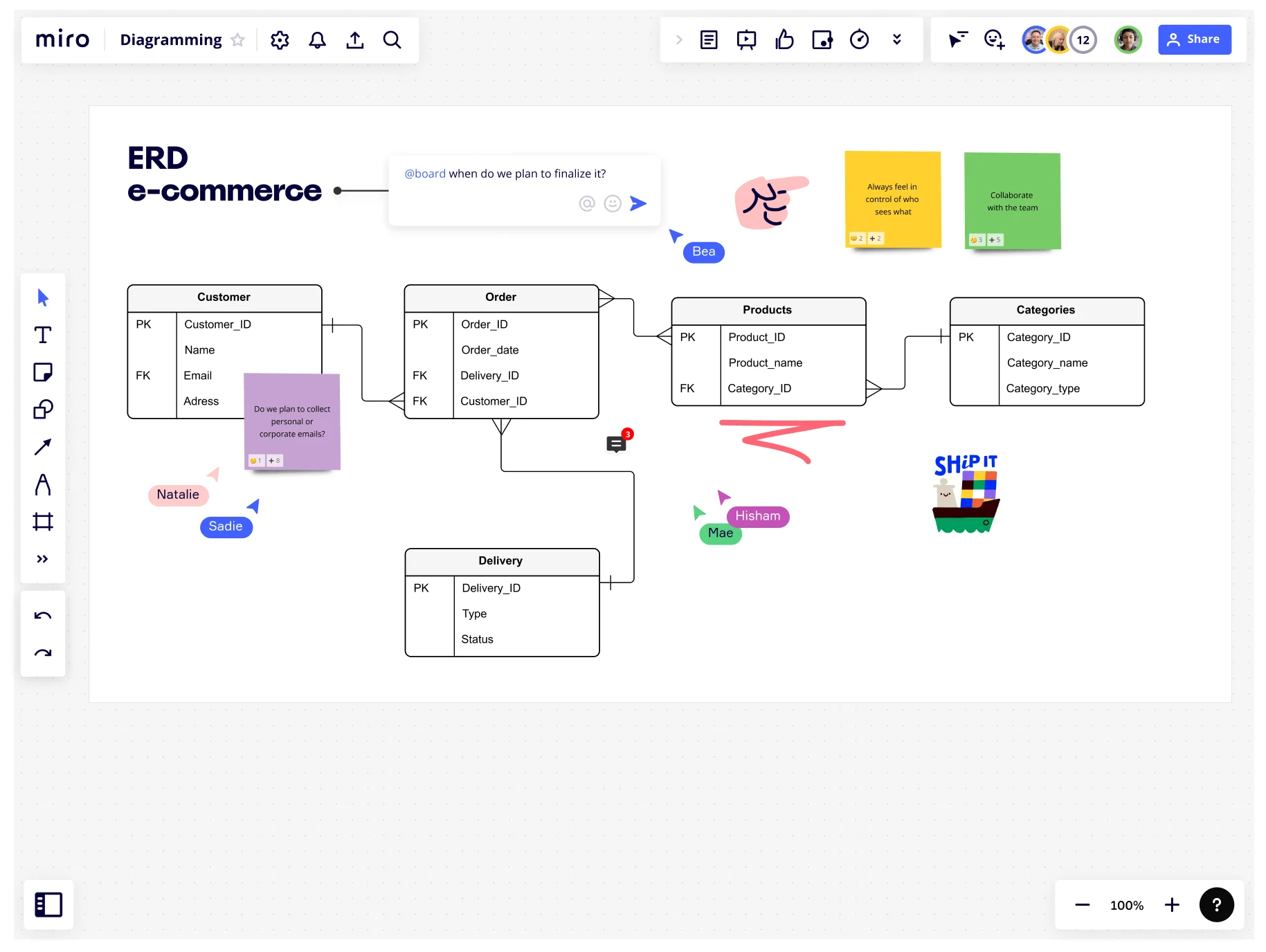
Troubleshoot systems and databases using an ER diagram tool .
Business Administration
For a business administrator, the daunting task of managing the departmental structure and changes can be simplified with graphic organizers. Organizational charts, flowcharts, and other visual aids help communicate complex information to staff members. These tools optimize business operations, create more efficient teams, and foster collaboration between management and teams. By streamlining work processes with graphic organizers, departments can save time and resources so the company can run like a well-oiled machine.
Art and Design
As a creator, designer, or artist, it can be challenging to stay inspired, especially during a creative rut. A graphic organizer can break through creative barriers by quickly mapping out ideas, giving creative individuals more space to explore and refine them. Adding a graphic organizer to the creative process leads to more productive, fulfilling, and even out-of-the-box work as the artistic vision takes shape.
When it comes to teaching, graphic organizers are a game-changer. Not only do they help educators and students visually break down complex subjects, but they also promote engagement and collaboration in the classroom. By learning to organize their thoughts visually, students can more intuitively connect ideas, identify relationships, and give their own insights. This creates a more interactive learning environment that builds better comprehension, retention, and critical thinking skills. Whether it's a Venn diagram to compare and contrast, a timeline to sequence events, or a circle map to generate ideas, the possibilities for using graphic organizers in the classroom are endless.
How to make a graphic organizer
Now the question is, how to make a graphic organizer that works for you? Don’t worry - it's simpler than you think. You can create an effective tool for everything you need in just a few steps.
1. Decide what you want to organize
The first step in creating a graphic organizer is simple – decide what you want to organize. This could be anything from project tasks to brainstorming ideas. Before you begin, take a moment to identify the main ideas or concepts you want to capture and categorize. Clarify your goals and objectives to ensure your graphic organizer will be tailored to your needs.
2. Choose a type of graphic organizer
Once you have a clear idea of what you want to organize, it’s time to choose a graphic organizer. Everyone has a unique way of processing information, so a good tip is to find one that aligns with your thoughts. For example, if you prefer to approach tasks step-by-step, a sequence of events graphic organizer is a good fit. If you enjoy seeing the big picture, a circle map will work wonders. The ultimate goal is to find an organizer that complements your thinking process to achieve your purpose.
3. Set up a collaborative workspace
Set up a collaborative workspace to take your productivity to the next level. A collaborative workspace is a shared virtual or physical space where people can work together on a task or project. Online visual collaboration spaces, including popular options like Miro , let you use graphic organizers and other tools to share ideas, organize information, and work more efficiently with others wherever you are.
4. Brainstorm and collaborate
With a collaborative workspace, you can start brainstorming and working with others. A great way to add more depth to your graphic organizer is to generate a range of ideas related to your topic, so you can understand different perspectives or identify blindspots. Collaborating with others and pooling your ideas together further helps you create a detailed graphic organizer that reflects all the key ideas related to your topic.
5. Regularly review and revise
Review and revise your graphic organizer regularly to ensure it's still working for you. Stumbling upon new ideas and information while working on your project is natural, so update them as needed. Set aside time each week to go through your organizer to make any necessary changes so you stay on track and meet your goals. Plus, it's a great way to see your progress and feel motivated to keep going.
Build graphic organizers collaboratively with Miro
In this article, we explored how using graphic organizers helps you visually convey complex ideas, present information, dissect problems, and find solutions. With Miro, our collaborative online workspace, you can collaborate and create graphic organizers with others using tools like digital whiteboards and template libraries. We’re designed for professionals, educators, students, and anyone looking to spice up their workflow. Try Miro today to see how we transform the way you work.
Get on board in seconds
Join thousands of teams using Miro to do their best work yet.

IMAGES
COMMENTS
Example 3: Compare and Contrast Essay Graphic Organizer. This is a compare and contrast essay graphic organizer template. The first paragraph of a compare and contrast essay introduces the essay topic, and it is always written at the top. In the first paragraph, the writers write down their ideas and concepts.
A compare and contrast graphic organizer helps you utilize your study to compare and contrast two or more ideas, perspectives, events, policies, and people. Depending on your requirements, you can use this organizer in different ways, as listed below. Compare and contrast two huge ideas like constitutional democracy and direct democracy.
Charts. A chart diagram (also called a matrix diagram or a table) is a type of graphic organizer that condenses and organizes data about multiple traits associated with many items or topics. Charts can be used to show attributes of items, to compare and contrast topics, and to evaluate information.
Remember, a compare and contrast graphic organizer online tool is a flexible tool that can be adapted to suit many learning and decision-making contexts. Benefits of Using Compare and Contrast Graphic Organizers 1. Enhances Critical Thinking. By organizing information visually, compare and contrast graphic organizers enhance critical thinking.
The best graphic organizers to compare and contrast are either the Venn diagram or the t-chart. The Venn diagram is better for comparisons of ideas but can get too cluttered in the overlapping ...
Cause and Effect Graphic Organizer 1 Compare/Contrast Graphic Organizer 2 Concept Definition Map Graphic Organizer 3 Drawing Conclusions Graphic Organizer 4 Identifying Author’s Purpose Graphic Organizer 5 Main Idea and Supporting Details Graphic Organizer 6 Making Inferences Graphic Organizer 7 Summarizing Graphic Organizer 8
Comparison and Contrast Graphic Organizers. This section delves into the types of graphic organizers that help in delineating the similarities and differences between various elements. Venn Diagrams. Venn Diagrams are circles that overlap to illustrate the similarities and differences between different sets.
2.6. Graphic Organizers for Compare and Contrast. 2.6.1. 19. Double bubble map. 2.6.2. 20. Venn diagram. 2.6.2.1. Add to Our List of Graphic Organizers for Teachers and Students. What are Graphic Organizers. A graphic organizer is a teaching and learning tool that is used to organize information and ideas in a way that is easy to comprehend and ...
The Essay Map is an interactive graphic organizer that enables students to organize and outline their ideas for an informational, definitional, or descriptive essay. The Comparison and Contrast Guide outlines the characteristics of the genre and provides direct instruction on the methods of organizing, gathering ideas, and writing comparison ...
Use a triple Venn diagram template to compare three different subjects.. 2. Tree chart. Like its name, a tree chart is a graphic organizer that shows information in the structure of a tree, with the main topic at the top of the chart and subtopics branching off it.